Last Updated on November 4, 2023 by
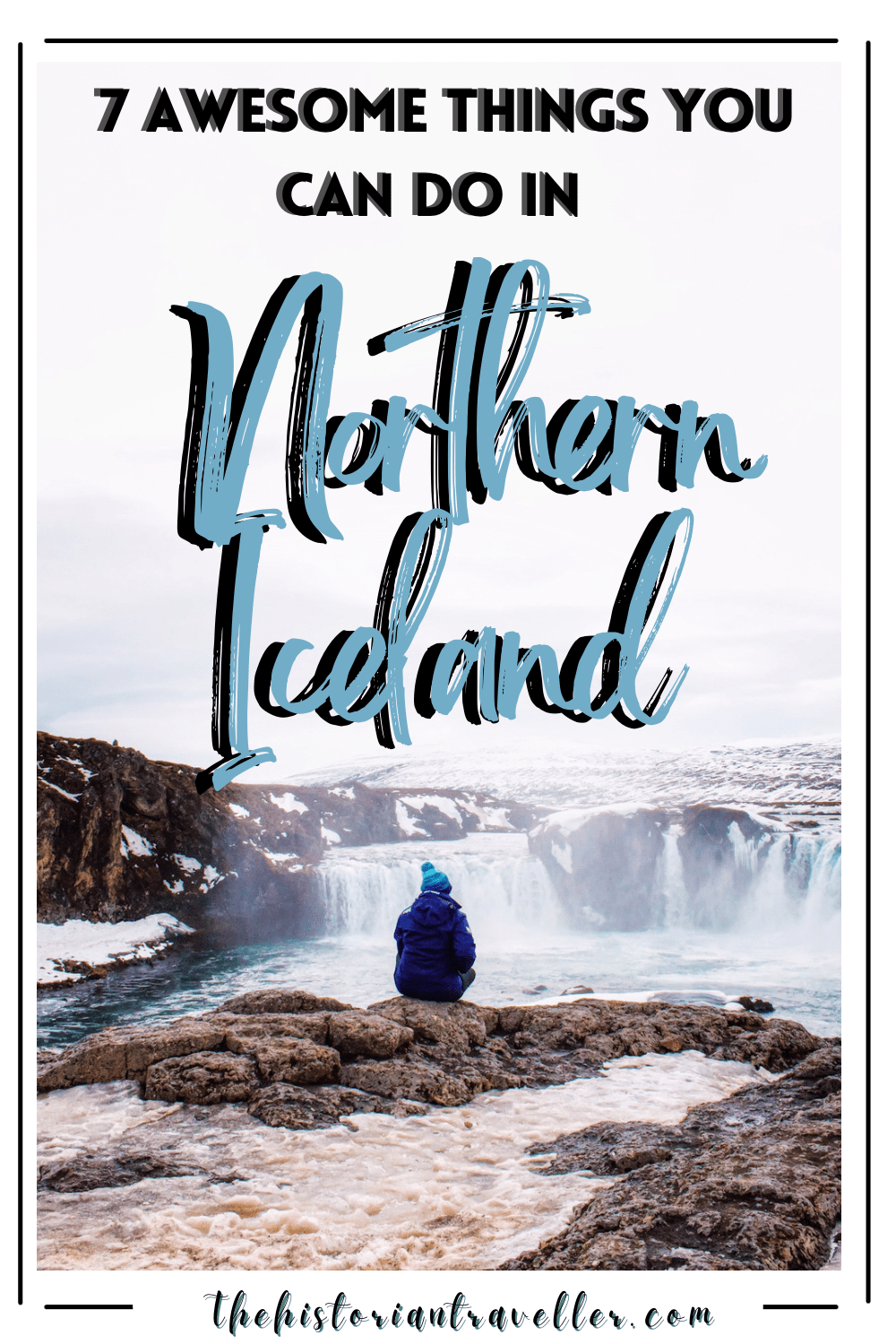
Northern Iceland is often overshadowed by the abundant mind-blowing landscapes of the South, but it’s truly a diamond in the rough, waiting to be discovered. While venturing north is sometimes considered an adventure for the brave, I firmly believe that Northern Iceland is a fantastic alternative to the more frequented paths in the country. If you’re seeking an experience beyond the the busy roads of the Golden Circle, then heading north is the way to go. In this guide, you’ll find a detailed itinerary for a 2-3 day road trip to Northern Iceland, offering insights into the best things to do and helping you plan your next fantastic adventure in this remarkable region.
Table of Contents
Tips for Visiting Northern Iceland
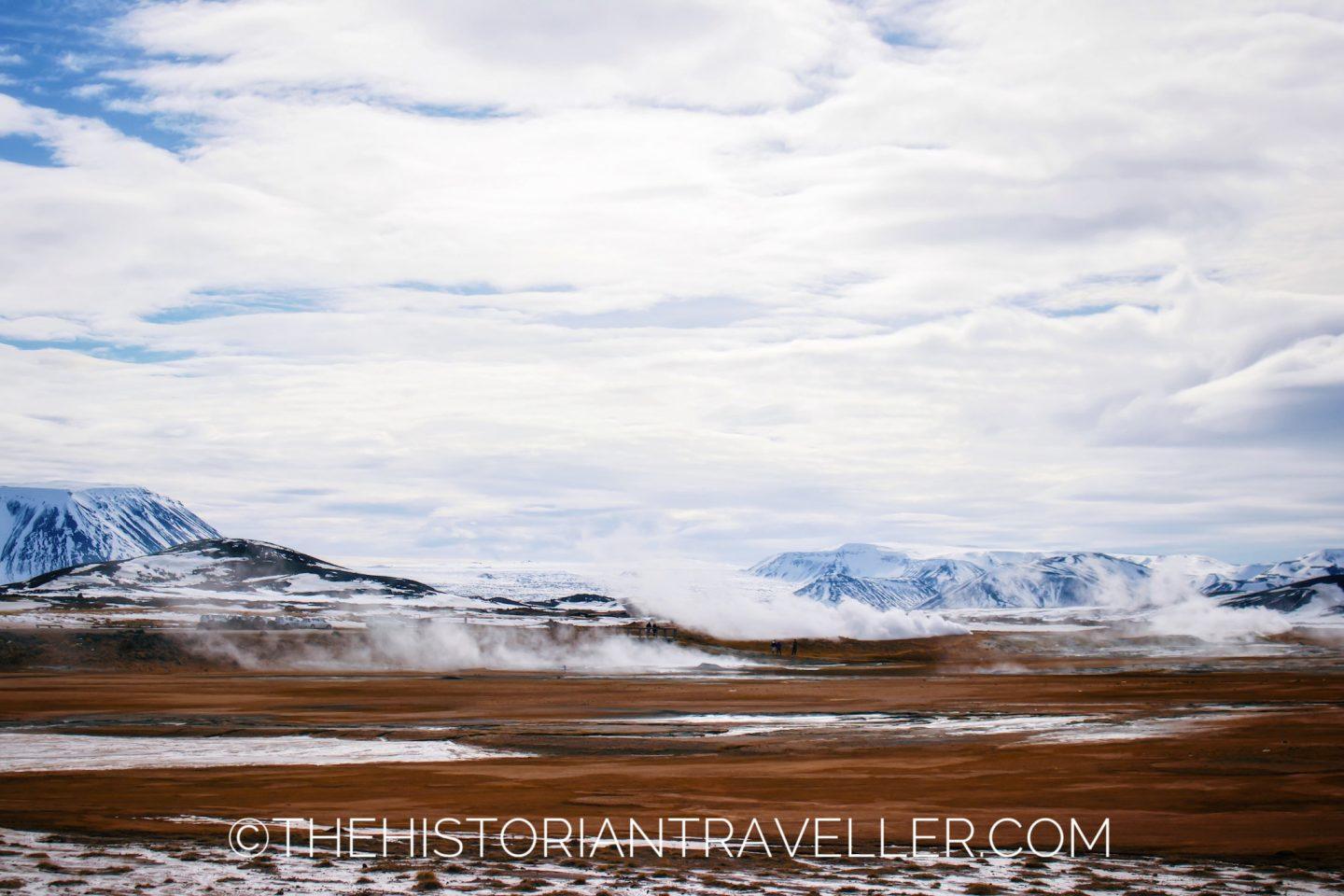
In this section, you will find the best tips to plan your adventure to Northern Iceland. Indeed, this part of the country, is slightly different from the Southern part, making travel slightly challenging in adverse weather conditions.
When is the best time to visit Northern Iceland?
The roads and weather conditions in Northern Iceland can be quite different from other regions of the country, particularly to the more touristy areas. While visiting during winter has its advantages, such as the chance to witness the Northern Lights, it also comes with potential hazards such as heavy ice on the roads and adverse weather conditions. For the most comfortable and accessible experience, the best time to visit Northern Iceland typically ranges from late April to mid-October. However, for personal experience, during April, you might still encounter some icy roads, but most of the attractions are open and visitable, providing a more pleasant and safer travel experience.
Road accessibility and weather conditions in Northern Iceland
It’s crucial to consider the timing of your visit to Northern Iceland, especially in terms of road accessibility. While other areas of Iceland may have passable roads, some routes in Northern Iceland might be closed due to snow and ice. For example, when we visited in April, we couldn’t access Dettifoss because the road was blocked by snow and ice.
Weather in Iceland can be highly unpredictable and this might affect your journey in a serious way. For this reason there are two essential tools that you need to keep handy for your journey. The first is the app Veður. This is developed by Icelandic Meteorological Office and gives you accurate weather predictions for your area. This includes also notifications for potential weather hazards in your area (e.g. we received one when we were in Reynisfjara).
You can download Veður on both IOS and Android.
The second, is the Road and Weather conditions live updates from Road.is. There used to be an app but this has been discontinued and now you can check live updates here. This is a very useful tour if you are doing an Iceland road trip as it gives you an easy to understand and updated report of most roads in the nation.
Lastly, Avoid driving at night on unfamiliar and icy roads, and whenever possible, stay on the Ring Road if you have doubts about road conditions. Icelandic roads can become extremely treacherous in unpredictable weather conditions. Your safety should always be the top priority, so exercise caution and make informed choices when traveling in these conditions.
Dining and Grocery in Northern Iceland
It is wise to plan your activities in advance, especially where and when you intend to dine. Dining options can be limited in this region. Therefore, I recommend choosing one of the main cities like Húsavík or Akureyri, which offer more extensive services. If you’re staying in an isolated location, be sure to pack groceries before starting your trip. Indeed, there are not many supermarkets along the road in the more remote areas of Northern Iceland. If you are driving longer stretch of road ensure to check the fuel stations and any supermarket/restaurants along the way before embarking on your journey.
Proper planning will enhance your experience and ensure you have what you need during your journey.
What to wear in Northern Iceland
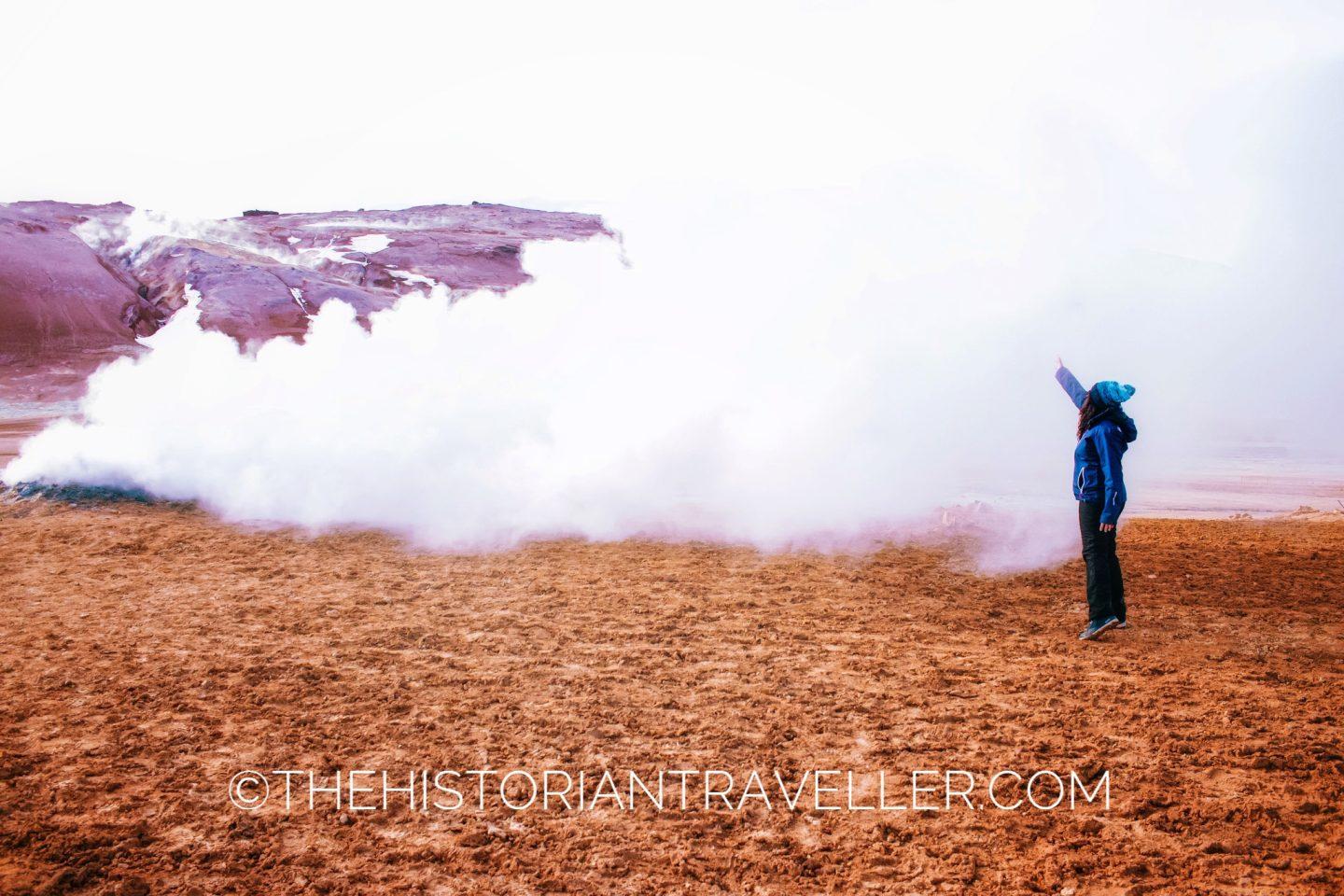
Wearing proper waterproof and insulated boots is a smart choice when visiting Northern Iceland. You’ll often find yourself walking on snowy terrain, and the temperatures in this region can be colder than in Southern Iceland. Wearing layers is always an optimal choice when visiting colder places.
How many days do I need to visit Northern Iceland?
Northern Iceland is a region brimming with incredible sights and natural wonders. To fully explore the area and experience all it has to offer, dedicating 5 days would be an optimal timeframe. However, if you are on a longer itinerary of Iceland or have time constraints, 2 or 3 days are still sufficient to cover the main highlights and immerse yourself in the beauty of Northern Iceland. It’s a versatile destination that can be tailored to different lengths of stay, ensuring a memorable experience regardless of your schedule.
Can I see the Northern Lights in North Iceland?
Absolutely! Northern Iceland is one of the best places to spot the Northern Lights, also known as the aurora borealis. It offers several advantages for aurora hunting, including being less populated, having longer hours of darkness, and experiencing less cloud cover than other regions. Lake Myvatn, in particular, is renowned as a top spot for Northern Lights viewing.
However, it’s important to note that the area can be quite challenging to navigate, especially at night and in icy conditions. If you plan to venture off the beaten path for Northern Lights viewing, it’s advisable to undertake an organized tour. These tours typically provide experienced guides and the necessary equipment to ensure a safe and successful aurora-watching experience in Northern Iceland.
Why I should visit Northern Iceland?
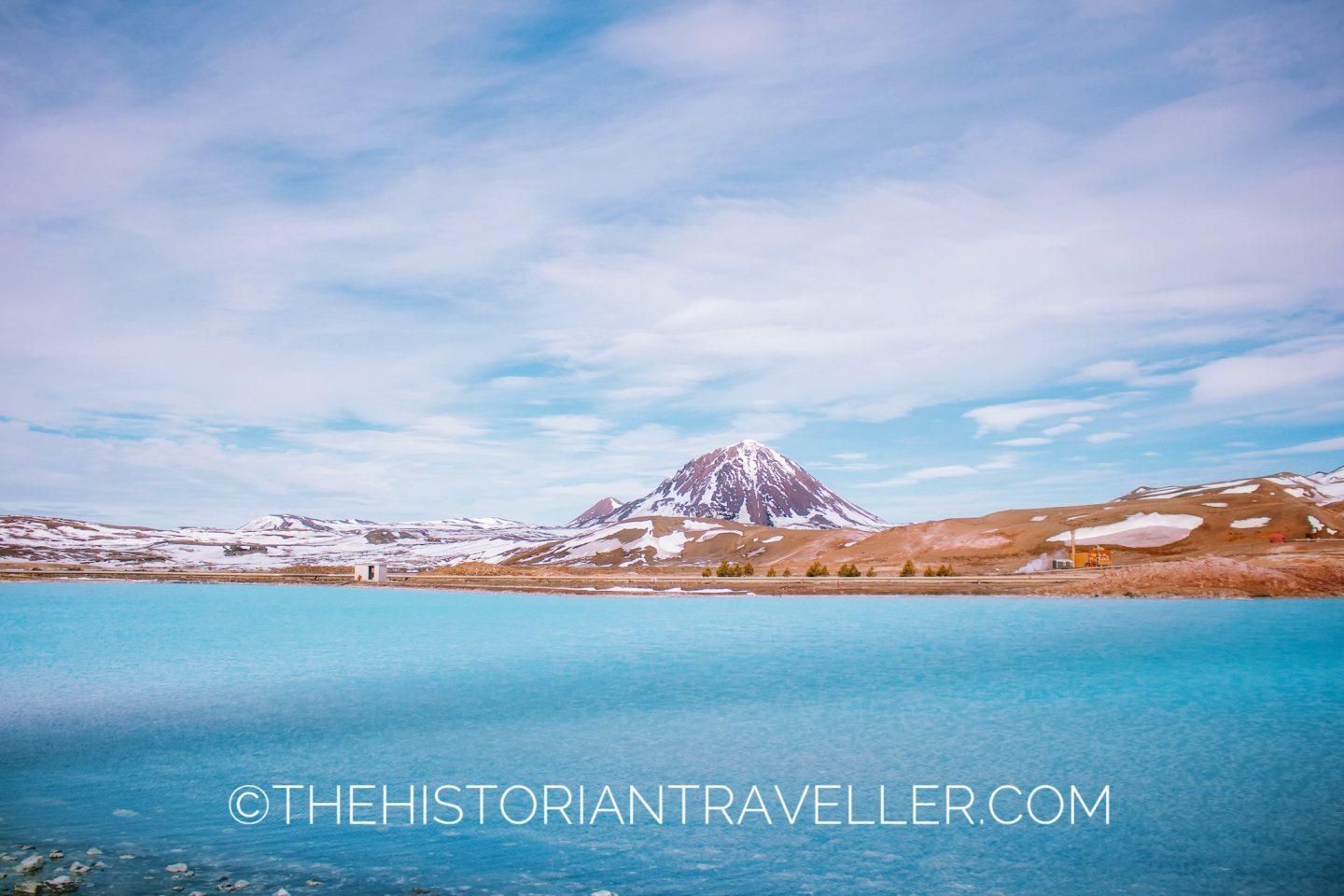
A Geological Heaven
The Northern part of Iceland is truly a geological heaven, offering some of the most breathtaking landscapes and dramatic scenery. This region has no reason to envy the more famous Southern Iceland, as it boasts equally stunning natural wonders. What sets Northern Iceland apart is its relative lack of tourist attention, even during high season. This means that, even at the peak of travel, you have the opportunity to explore and experience many places with a sense of solitude.
During the spring season, temperatures can be quite chilly in the northern areas, given their proximity to the Arctic Circle. However, outdoor life remains enjoyable, and there are ample opportunities for day trips and outdoor adventures. The region is so rich in natural beauty and attractions that two days hardly seem sufficient to take it all in. I wish we spent more time exploring it!
Two-day itinerary of Northern Iceland
The map of Northern Iceland below provides a suggested two-day itinerary that’s easy to follow and covers some of the region’s top attractions. If you have more time at your disposal, you can easily incorporate additional attractions and points of interest along the way to further enrich your experience in this captivating part of Iceland.
Day one in Northern Iceland
On your first day in Northern Iceland, a great starting point is the city of Húsavík (Point A). Here, you can stock up on groceries for the day and plan your activities. Húsavík is located approximately 69 kilometers from your next destination, Krafla (Point B). The drive is relatively short, taking about one hour, and the landscape along the way is absolutely breathtaking. Depending on the conditions of Krafla (for example, when we visited, it was entirely frozen), you can spend anywhere from 30 minutes to an hour exploring the area.
From Krafla, it’s a quick drive of less than 10 kilometers (about 12 minutes) to reach your next stop, the stunning and colorful landscapes of Námafjall (Point C). If you have spare time and a sense of adventure, you can opt for a half-day hike in the volcanic mountains of Hverir. Alternatively, after your visit to Námafjall, you can hop back in the car and head to the Grjótagjá Cave (Point D), which is only 5.8 kilometers away (about an 8-minute drive).
The final stop of the day is the magnificent Goðafoss waterfall. This is located approximately 53 kilometers from your current position, and the drive takes about one hour. For the first day, we decided to stay in a pod in the middle of nowhere in Laxamýri. This location is only 39 kilometers from Goðafoss, making it an ideal place to potentially spot the Northern Lights and continue with your Northern Iceland itinerary.
Day 2 on Northern Iceland
On your second day in Northern Iceland, you can begin in the city of Akureyri (Point F). This charming city offers plenty of opportunities for leisure, including exploring its lovely cafes and shops. You can easily entertain yourself here for a half day or more.
A second stop on your itinerary can be the delightful museum of Glaumbær (Point G), which is located approximately 102 kilometers from Akureyri. The drive will take around 1 hour and 20 minutes.
Admittedly, on our second day, we took it easy and enjoyed a more relaxed pace, as we had been on the road for several days by that point and wanted to enjoy the surrounding landscape. However, if you’re looking to add more spots to your itinerary, this part of Iceland offers plenty of attractions and natural wonders to explore. The choice is yours, and you can tailor your journey to your preferences and schedule.
Additional itinerary suggestions for Northern Iceland
If you have more time to dedicate to this wonderful region, I warmly suggest you to plan the following stops:
- Lake Mývatn and its Nature Baths is known for its stunning natural beauty. We visited briefly but not enough to consider it a proper stop. While there, you can consider relaxing in the Nature Baths, which are similar to the Blue Lagoon but less crowded. Entrance fee starts at 6,490 ISK per person.
- Dettifoss Waterfall is one of Europe’s most powerful waterfalls. As said before, this was one of our original stops but all the roads leading to the waterfall were closed for ice.
- The caldera of Askja is volcanic wonderland featuring a stunning caldera. Once you are there, if the weather allows it, you take a dip in the Víti crater’s geothermal lake.
- Hiking in the Súlur mountain. For those who enjoy hiking, consider adding an extra day to conquer the Súlur mountain, offering panoramic views and a rewarding outdoor adventure.
- Reykjafoss Waterfall is regarded as one of Skagafjörður’s hidden treasures. The path to reach the waterfall should be ok in every season.
7 awesome things to do in Northern Iceland
1. Go whale-watching in Húsavík
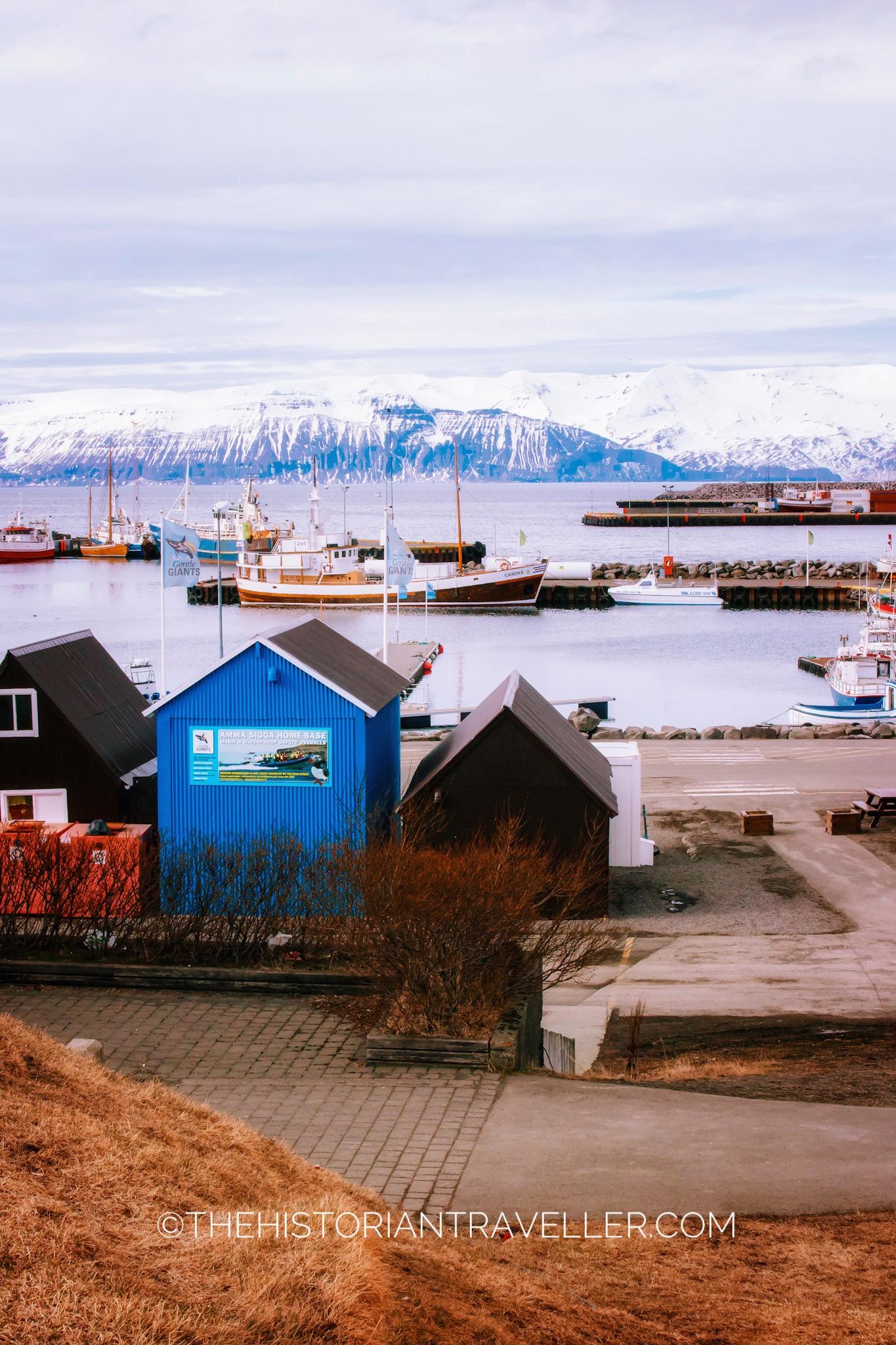
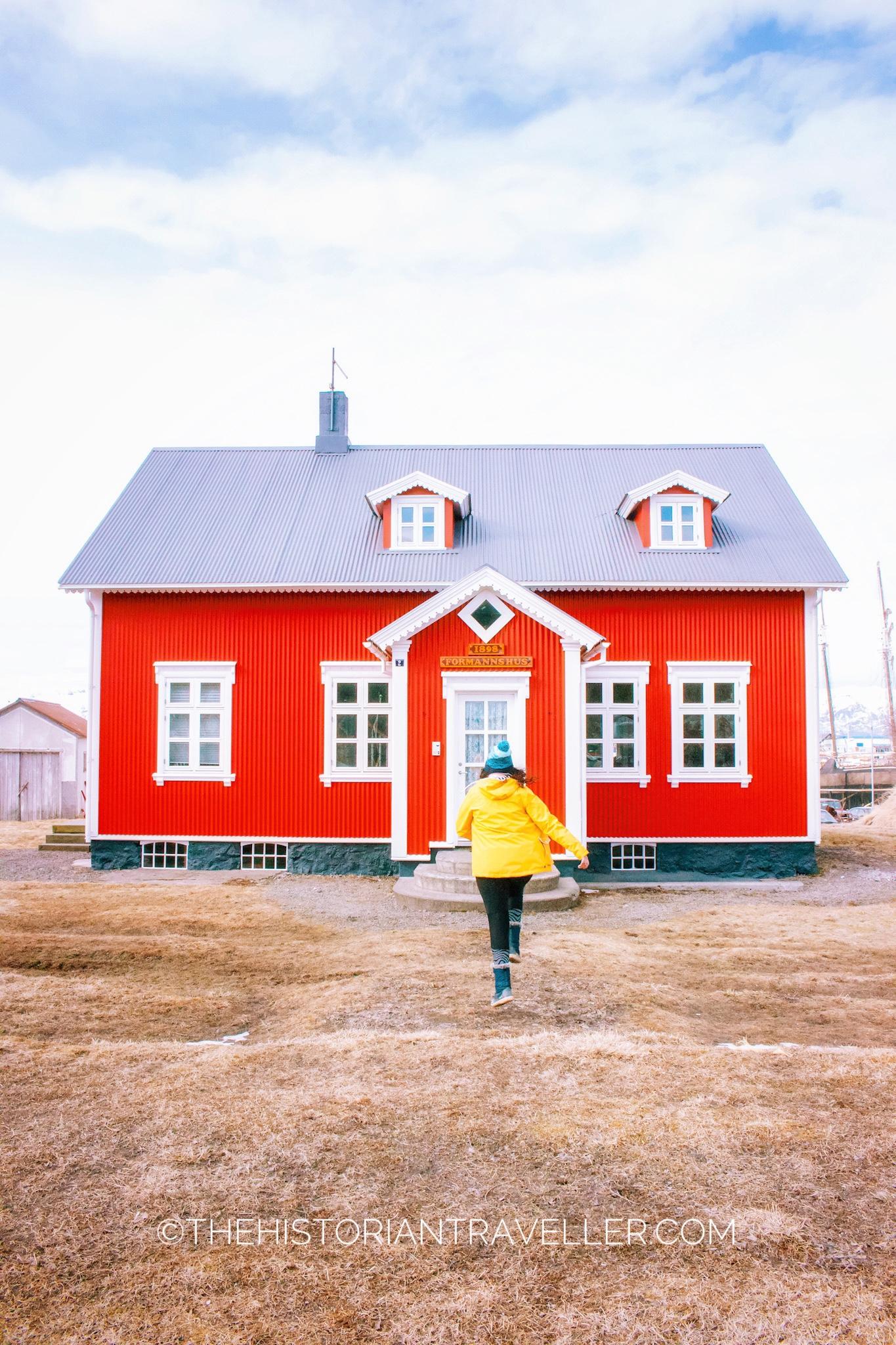
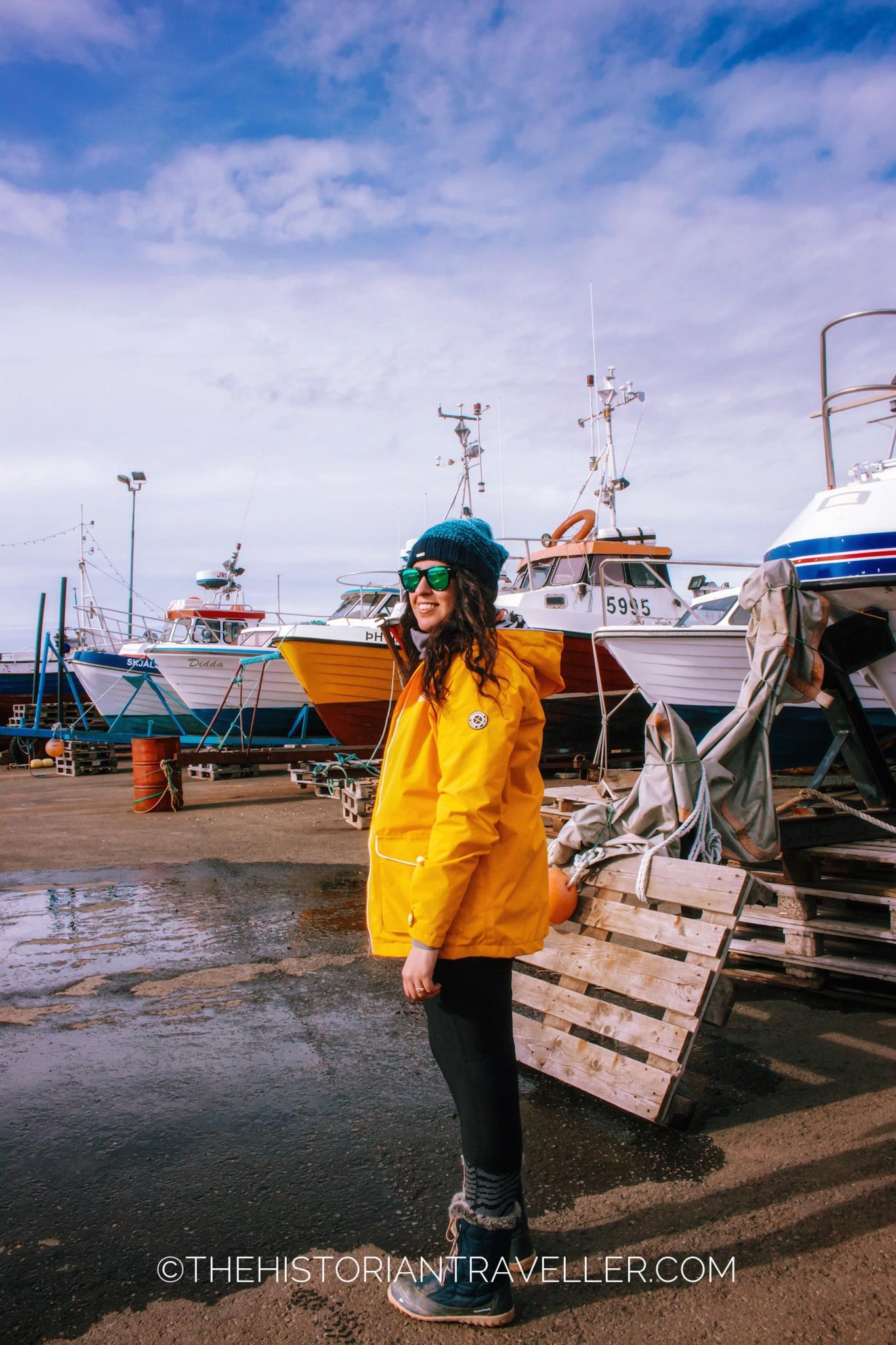
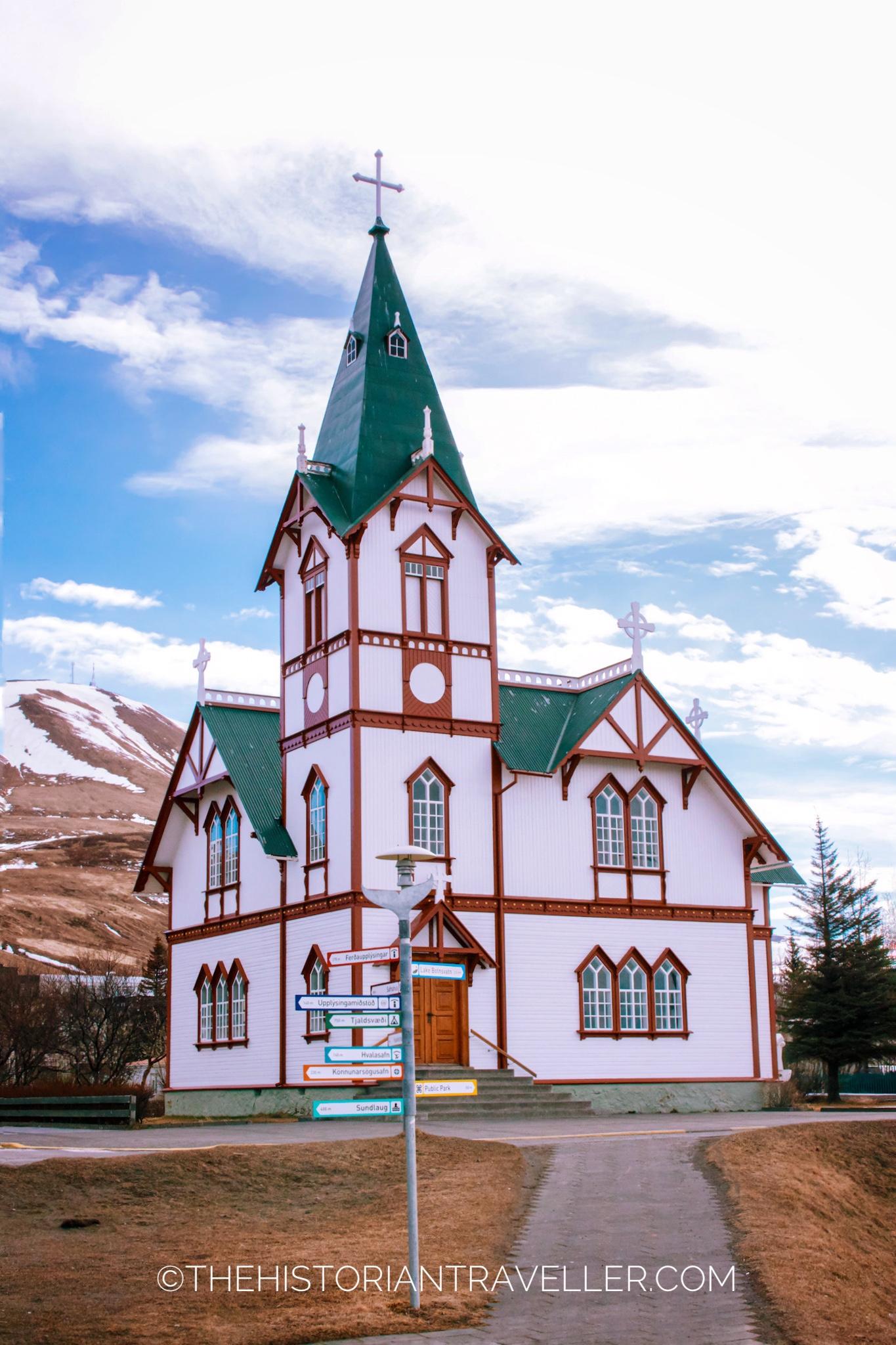
Húsavík, a charming small fishing town nestled along Skjálfandi Bay, has a rich history. Its name, which literally means “bay of the houses,” hints at its historical significance. Indeed, according to Icelandic sources, Húsavík may well be the oldest Icelandic settlement. It’s believed that the Swedish explorer Garðar wintered here in 867. This would make Húsavík the first inhabited Icelandic settlement, pre-dating Ingolfur Arnasson’s settlement in Reykjavik.
While there may be no physical remnants of the old Norse village, the town has since transformed into a beautiful and vibrant community. Today, Húsavík is celebrated as a major tourist hub. Every year, it attracts visitors with its natural beauty, whale-watching tours, and a range of attractions that make it a must-visit destination in Northern Iceland.
Other things to do in Húsavík
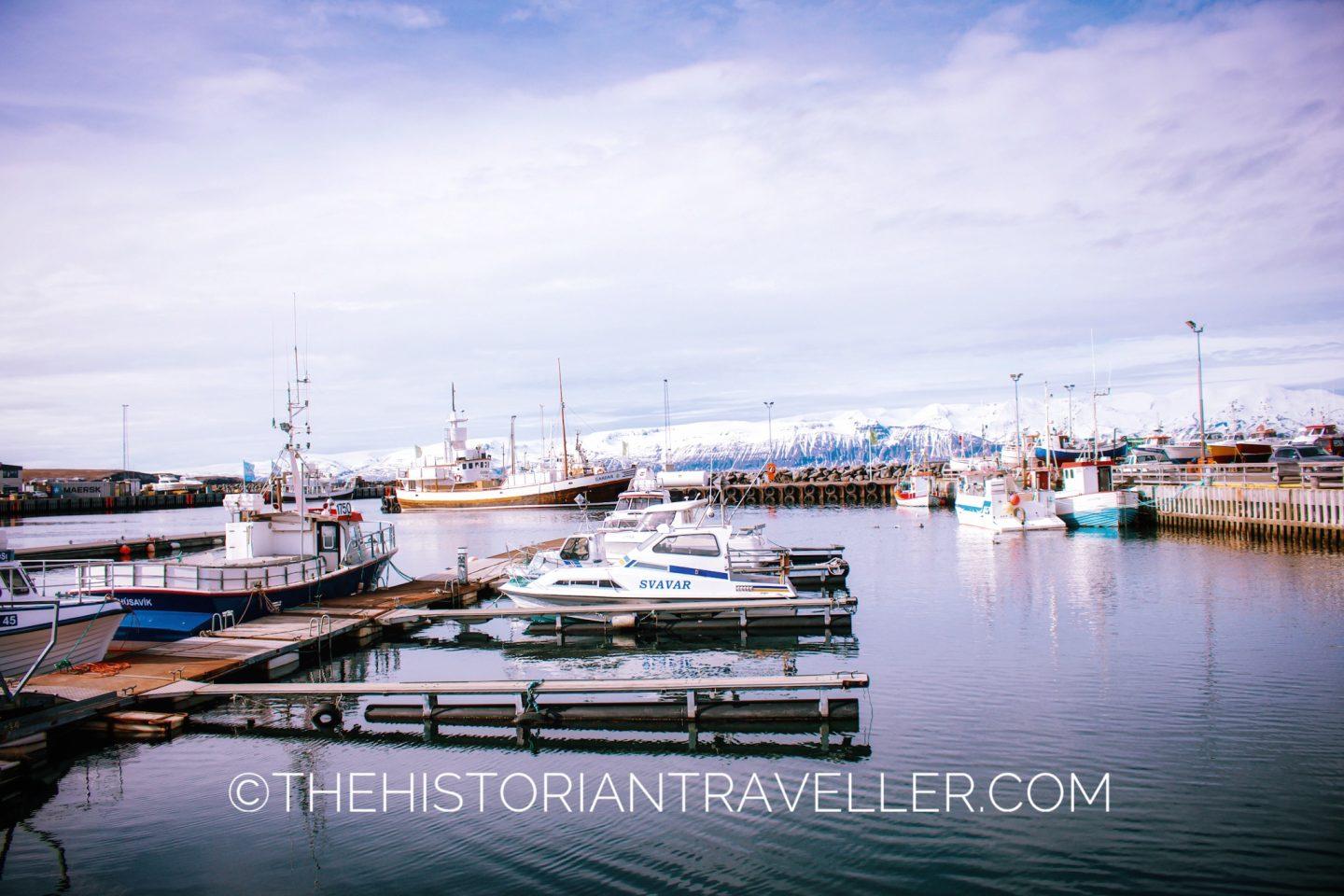
In Húsavík, if whale watching isn’t on your agenda or you’re looking for alternative activities, there are many other delightful options to explore in this charming town. You can take a leisurely stroll around its peaceful harbor, soaking in the maritime atmosphere and scenic views.
For those interested in culture and history, consider taking a cultural tour through the town’s museums. Two major museums in Húsavík are The Museum of Exploration and the Húsavík Whale Museum. Both of them offer valuable insights into the region’s heritage and natural wonders.
Don’t forget to visit the photogenic Húsavíkurkirkja, a wooden church that has graced the main street of Húsavík since 1907. This charming church is a visual delight and a piece of local history that you won’t want to miss during your visit to the city.
2. Hiking in the Krafla caldera
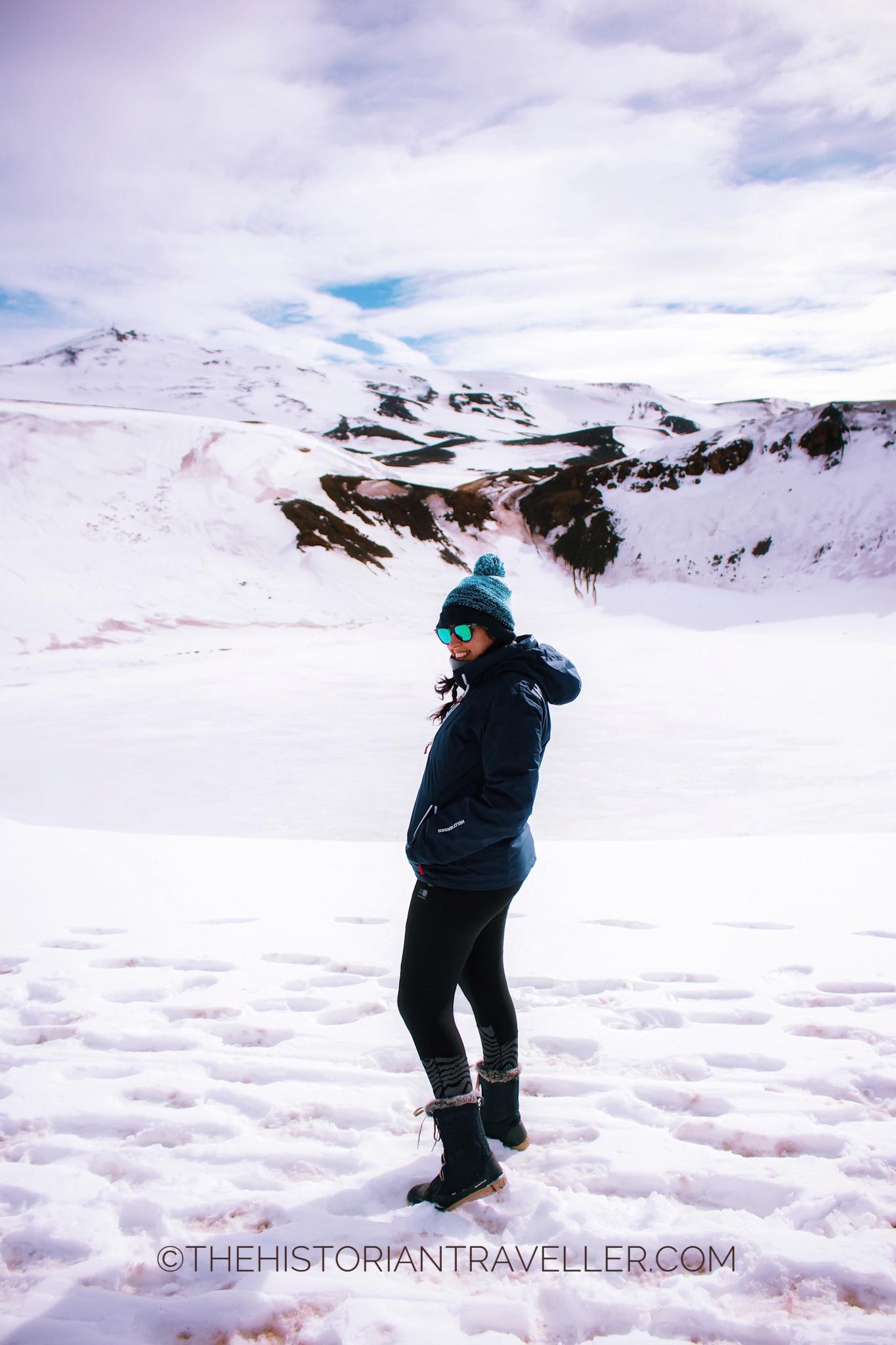
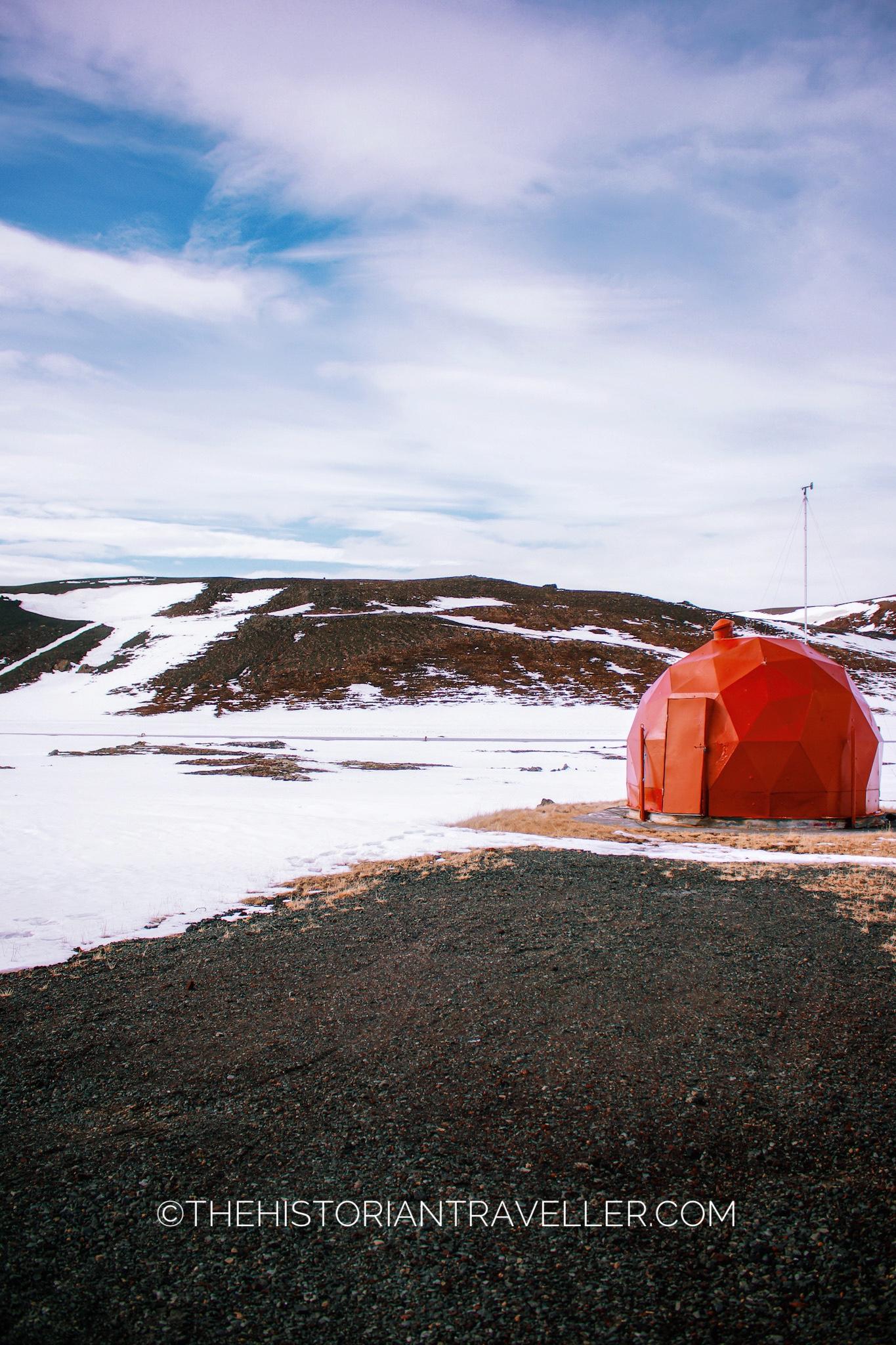
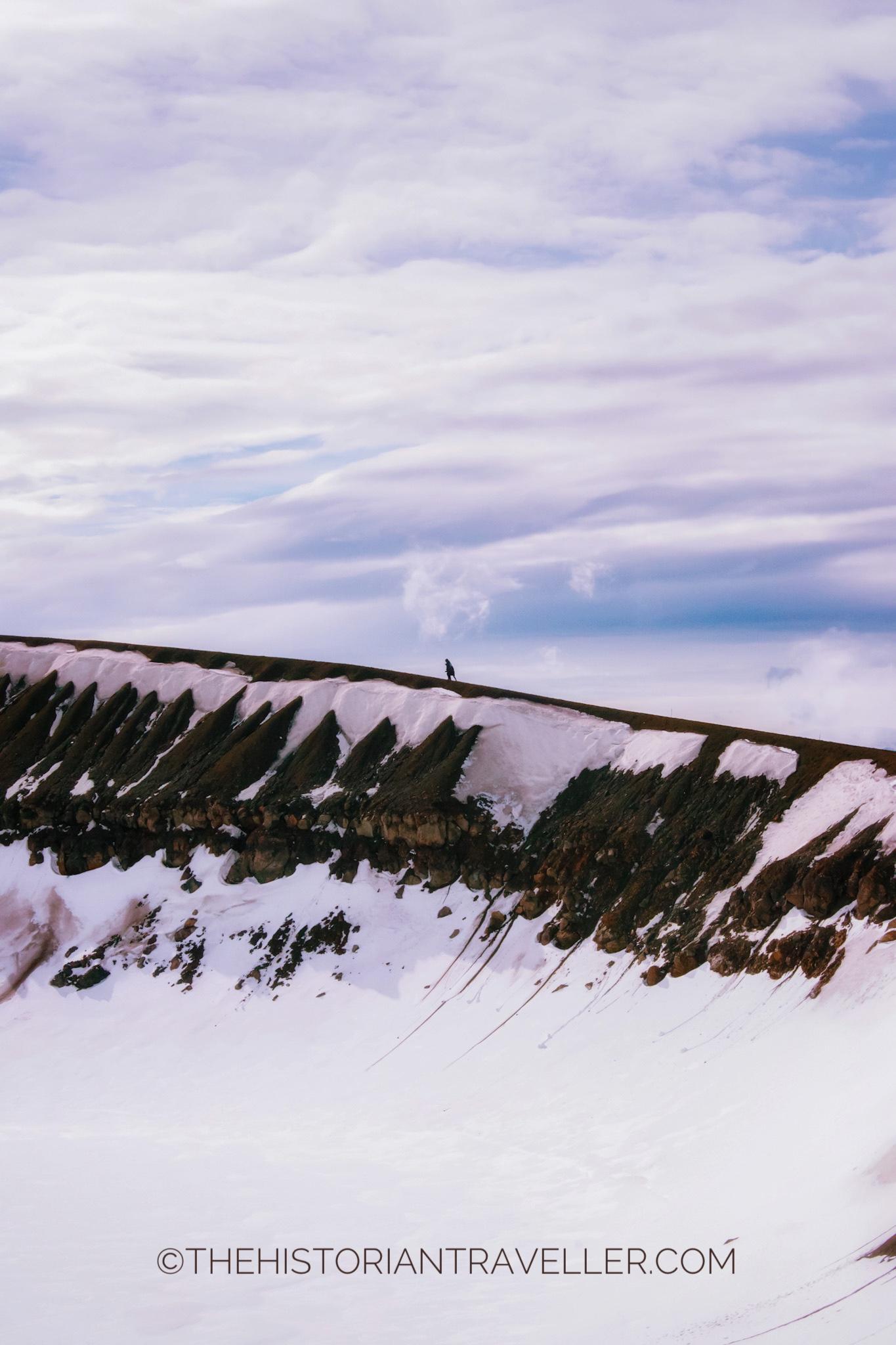
The caldera of Krafla, which features a main crater known as Viti (meaning ‘Hell’ in Icelandic), has a fascinating history. This crater was formed during a massive explosive eruption that began in 1724 and lasted for approximately five years. In the years following the eruption, the crater truly resembled a “boiling hell,” earning its fiery name.
Today, the Viti crater boasts a diameter of 300 meters. This is fully walkable, offering visitors the chance to explore its remarkable landscape. During the summer, you’ll find a stunning turquoise lake at the bottom of the crater, creating a picturesque scene. While we couldn’t witness this due to the frozen conditions during our visit (we just hiked up and down), the beauty of the Krafla area is still undeniable. The smoke rising from the volcanic ground added a unique mood to the atmosphere.
As you approach the crater, you’ll also encounter intriguing structures. These belong to the nearby Power Station, which operates in close proximity to the caldera. These structures, resembling lunar bases, are quite photogenic and add to the otherworldly ambiance of the area.
3. Walk in a Mars-looking scenery at Námafjall Hverir
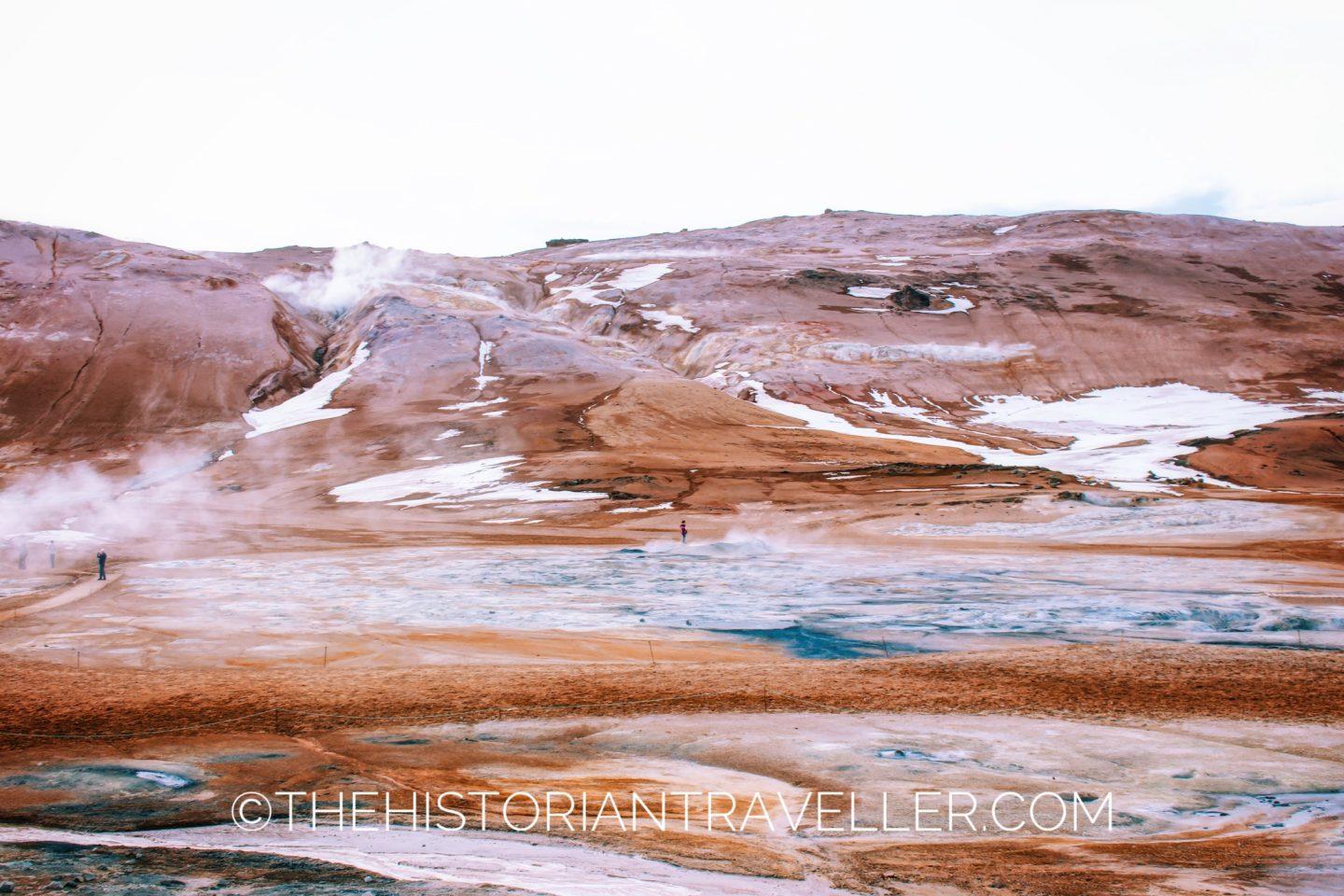
Can you see how beautiful is this scenery? Well, prepare yourself for an equal amount of smell! Indeed, these amazing colours are due to the sulphur crystals surrounding the mud pools and sulfataras characterising the area. The pungent smell is a testament to the geothermal activity beneath the surface. However, it’s remarkable how one can acclimate to the smell and fully appreciate the breathtaking landscape. Námafjall was undoubtedly one of the highlights of our Northern Iceland tour. Moreover, its expansive geothermal area is one of the largest in the country.
Námafjall’s accessibility from Lake Myvatn and the East Fjords makes it a convenient addition to the North Iceland itinerary. Especially if you’re planning a day trip to Krafla. The active fumaroles, that abound in this geothermal area, truly enhance the scenic beauty. This will make you feel as if you’ve stepped onto another world. It’s a surreal and captivating experience that will adds a unique dimension to your Northern Iceland journey
Visiting Námafjall Hverir. Things to know
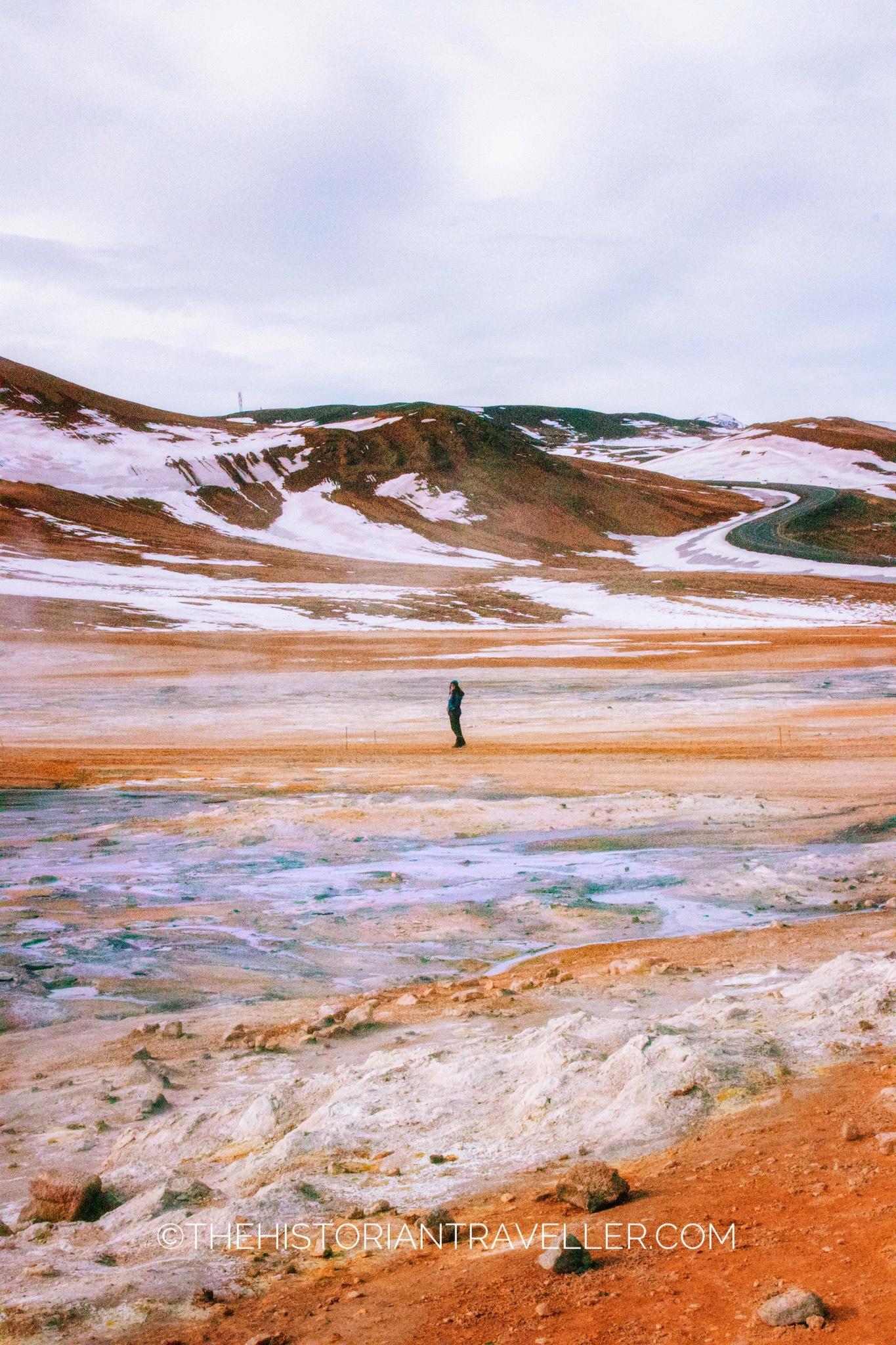
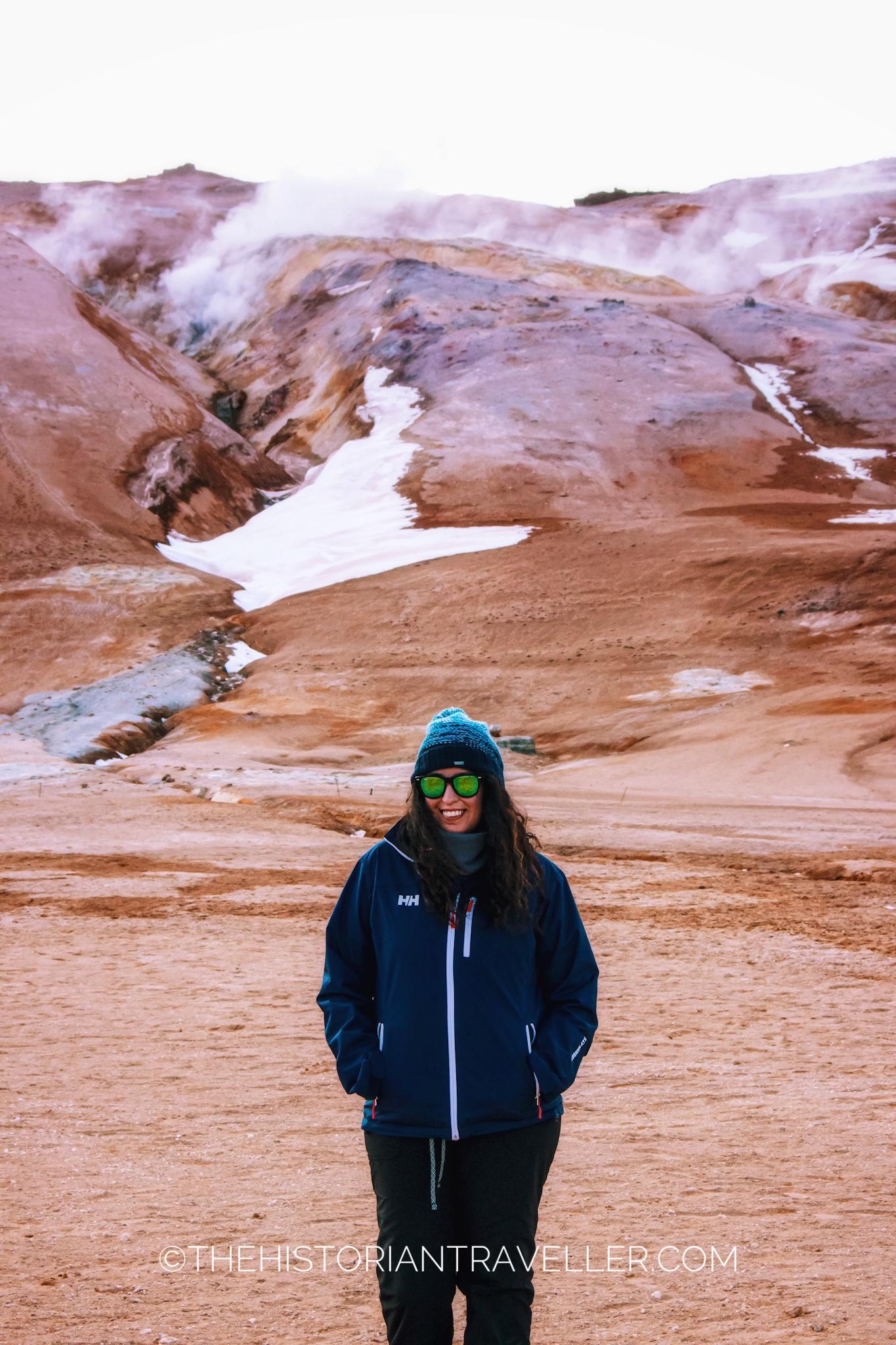
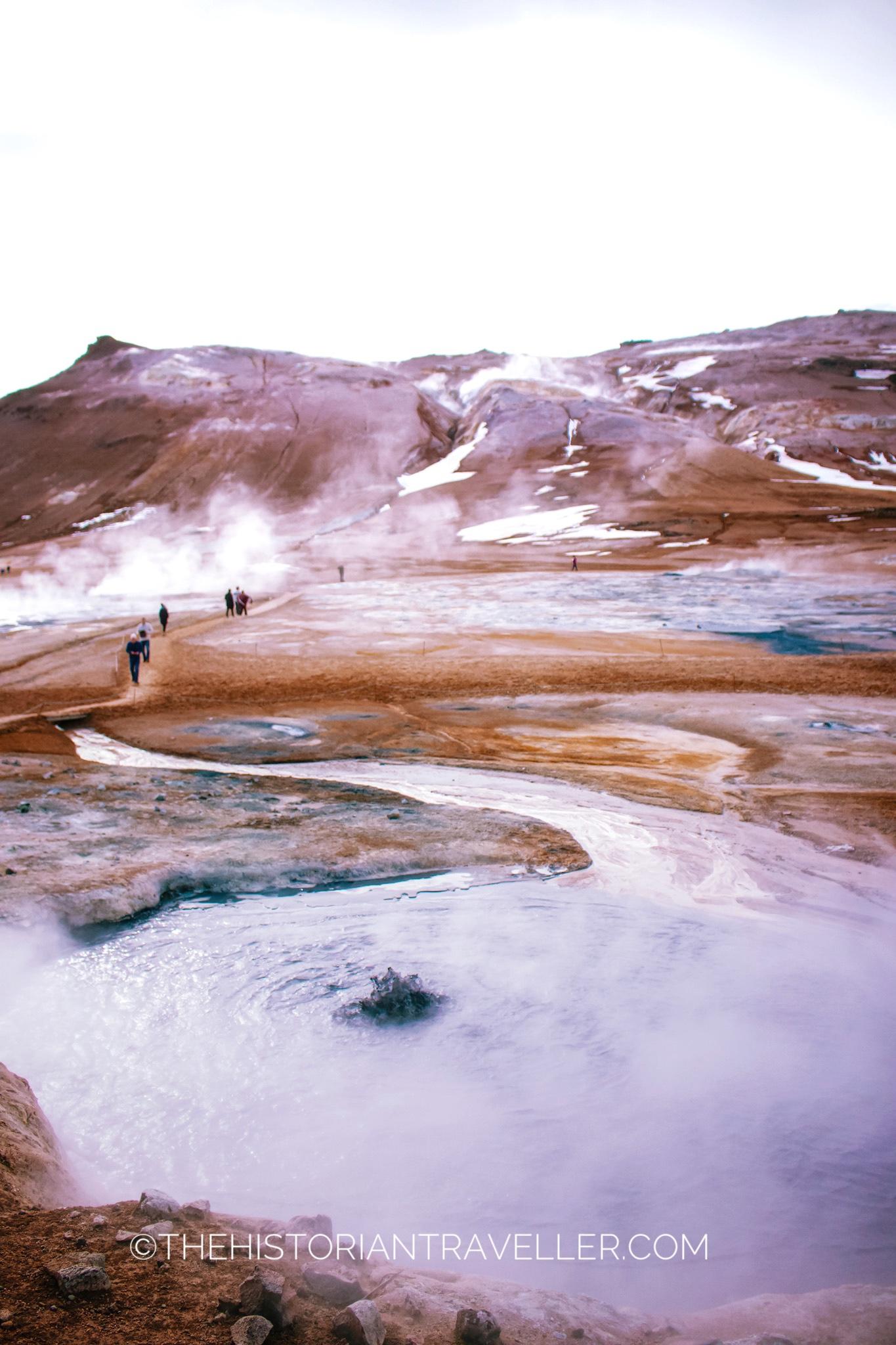
Navigating the Námafjall geothermal area requires caution. Indeed, the paths may not always be clearly visible, and getting too close to the mud pools can be dangerous. If you have the time and an adventurous spirit, the Námaskarð Pass hike is very recommended. Indeed, it provides an opportunity to delve deeper into a landscape that resembles something out of a science fiction novel, akin to the surface of Mars.
What’s even more mind-blowing is that despite its Martian appearance, Námafjall played a significant role in NASA’s training for the Apollo lunar missions. In fact, the geological conditions found in some Icelandic areas serve as planetary analogs to those of the moon.
The intense smell and the steam coming from the ground work as a good reminder of how powerful and beautiful is our planet! I really enjoyed my visit to this place and I hope to go for a second round tour!
4. Live a GoT adventure in the Grjótagjá Cave
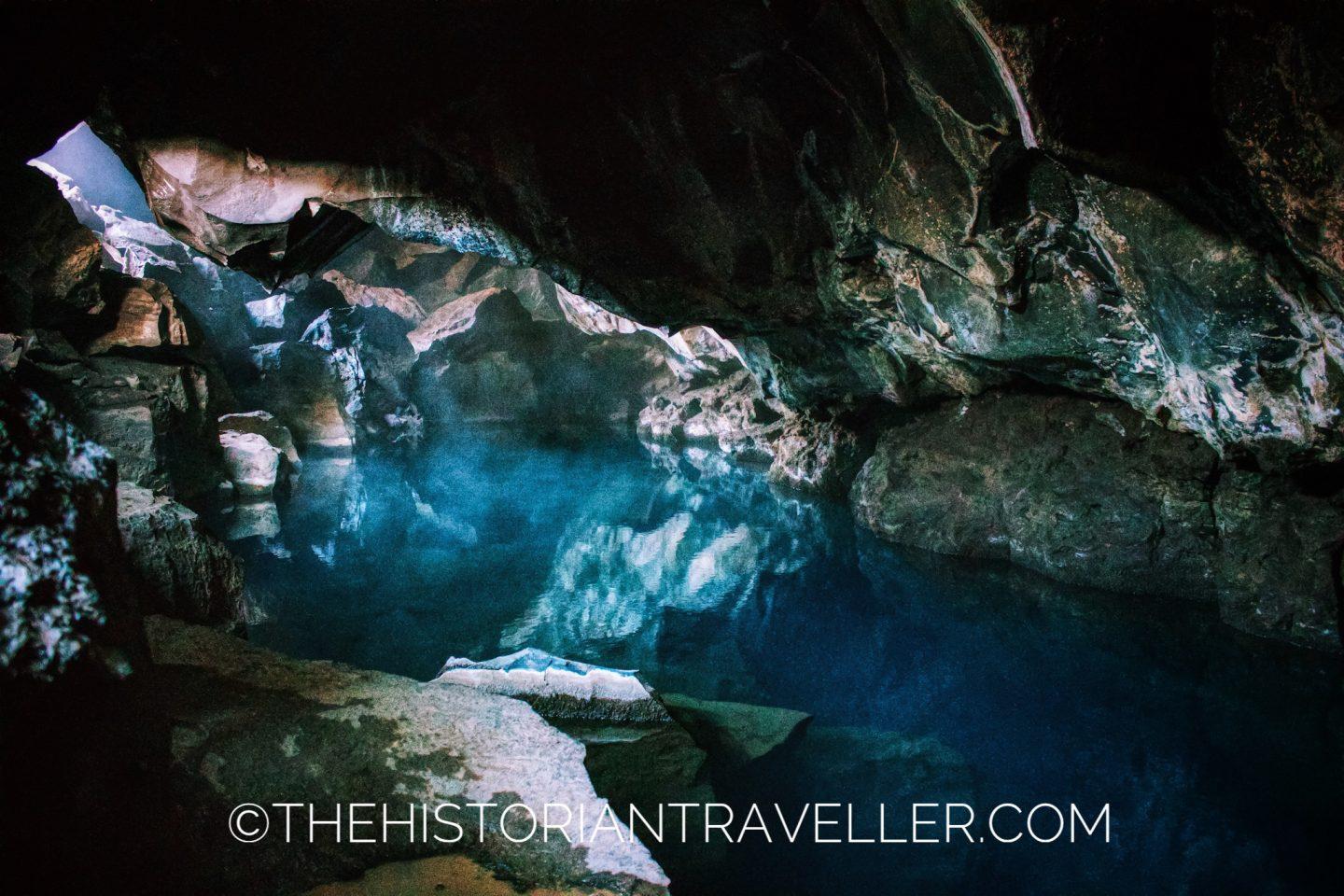
If you are a fan of Game of Thrones, you don’t want to miss the occasion of visiting this little hidden gem at just ten minutes from Námafjall and Lake Myvatn. Famous for being the Jon Snow and Ygritte’s cave, Grjótagjá was actually used as a thermal bath by Icelanders. Nevertheless, this was until the ’70, when a powerful eruption caused a sudden rise of the water temperature, which became above 50 degrees.
Today, bathing in Grjótagjá is not recommended. In fact, the water temperature is still very fluctuating passing from mild to boiling hot. The cave is also quite small and with a low ceiling. Unless you want to swim, I’m not sure it would fit more than five people.
5. Search for the Norse Gods at Goðafoss
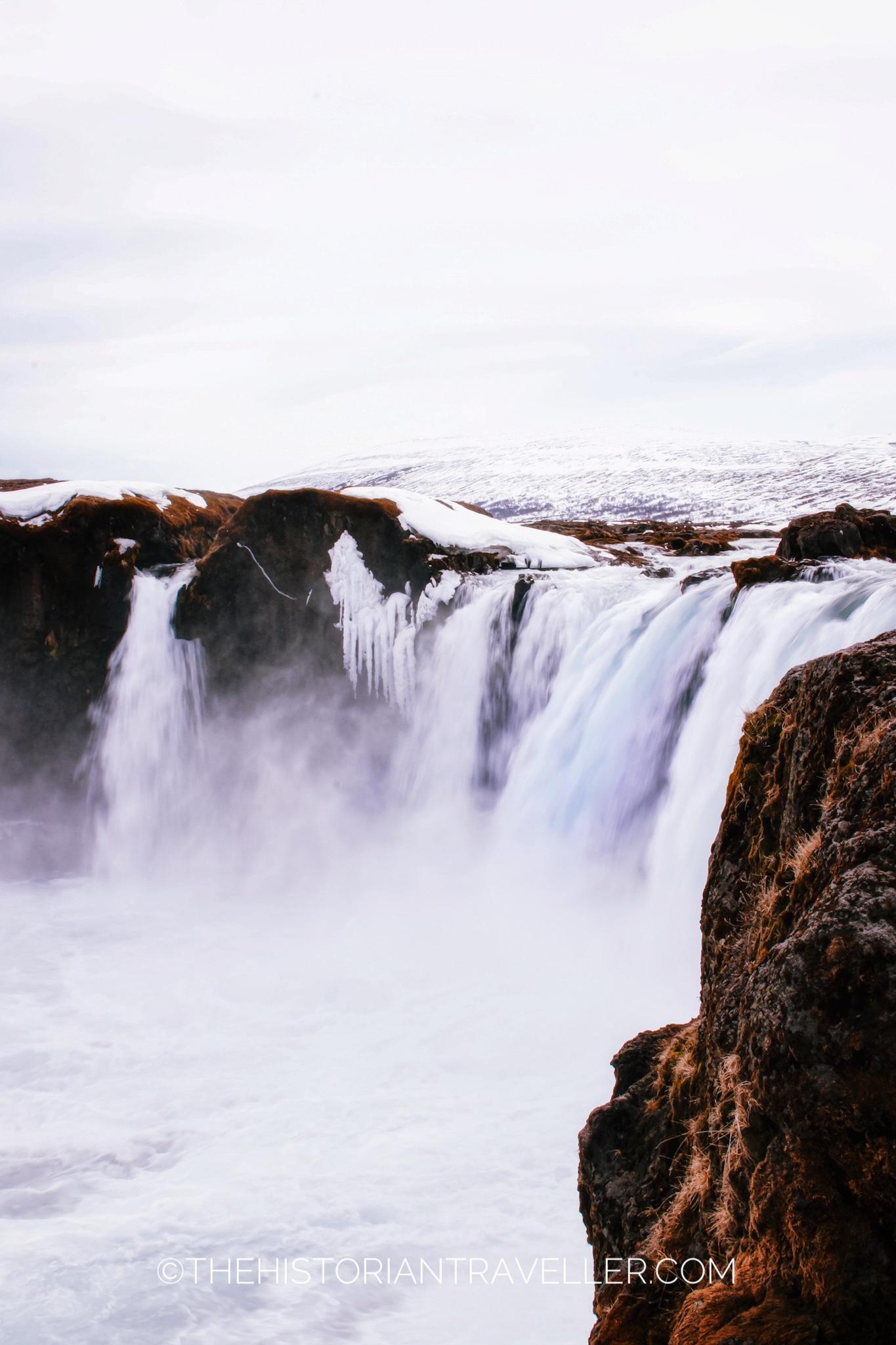
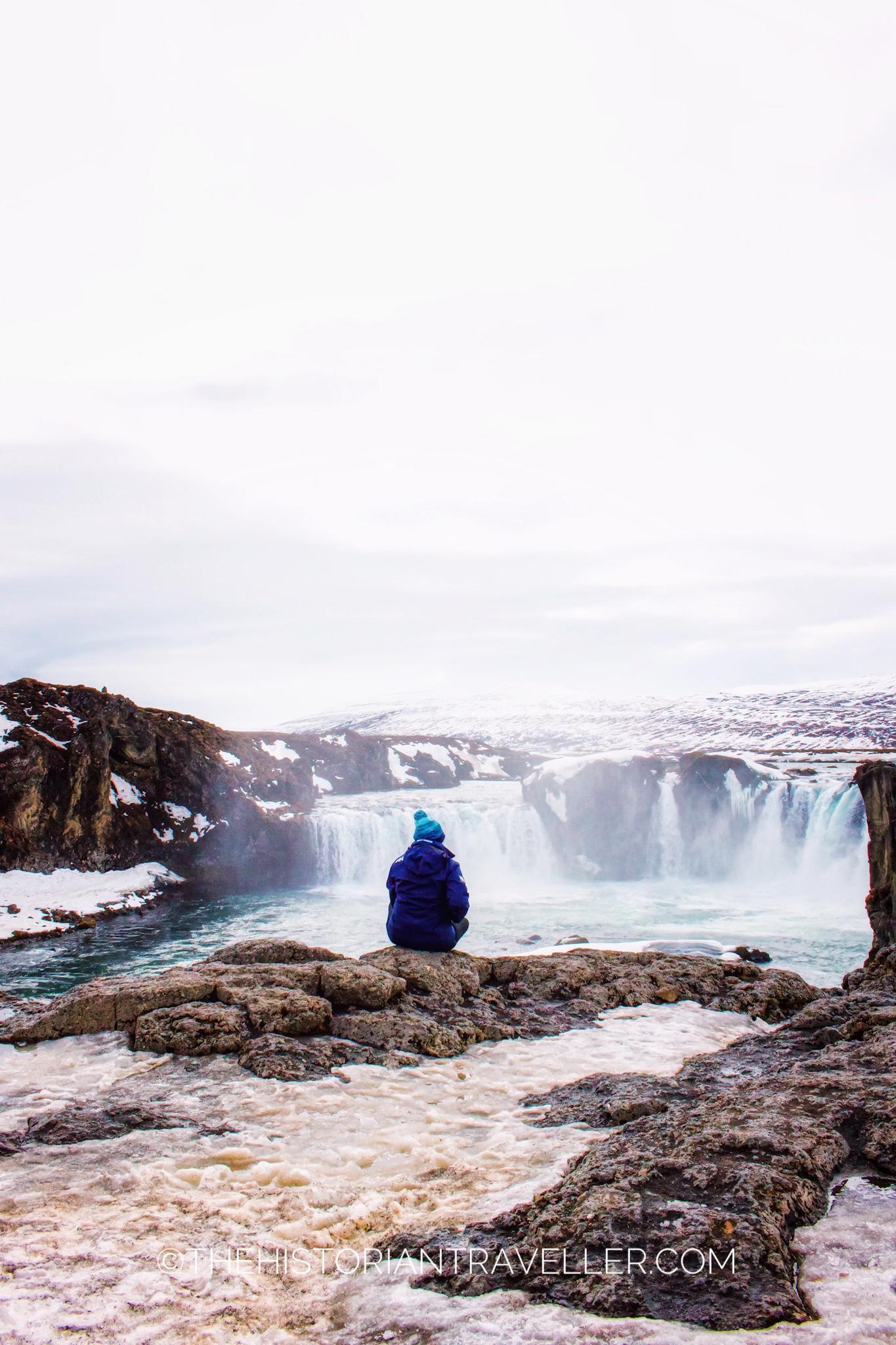
Have you ever visited a natural landscape that is also a piece of history? Well, Goðafoss is precisely that. In fact, its name literally means “Waterfall of the Gods.” The waterfall is nothing less than a reminder of a significant chapter in Icelandic history.
The name originates from a famous “episode” involving Þorgeir Ljósvetningagoði, a lawmaker of Þingvellir. He made the difficult decision to abandon paganism in favor of the new Christian religion in the year 1,000. According to the Icelandic Saga, this decision followed a very difficult and sleepless night. During this night, the Asatru priest, as a symbol of this change, cast the idols of the Norse Gods into the waterfall. From that moment onward, the waterfall acquired the name Goðafoss.
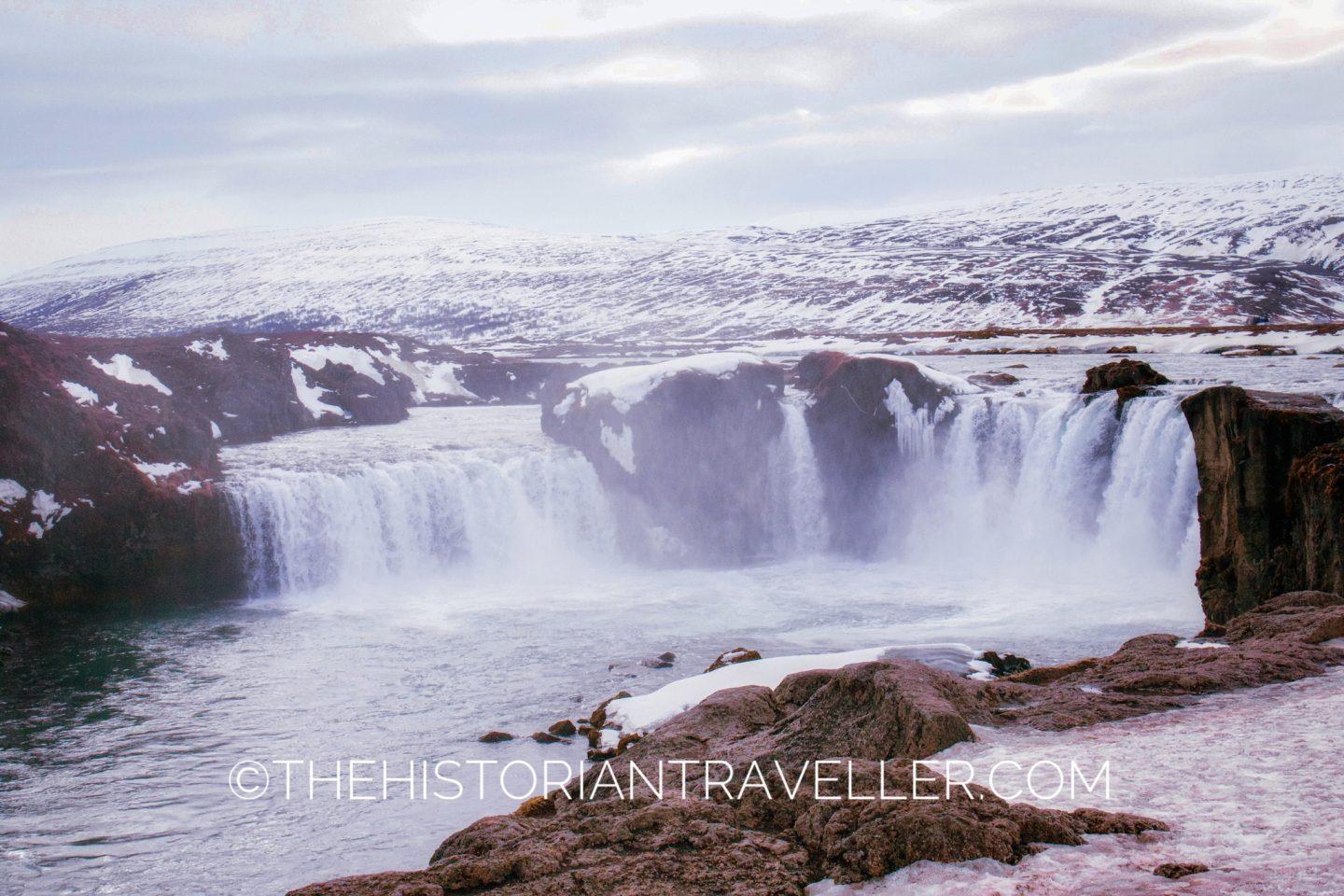
Reaching the waterfall is very easy. You can find it along the road between Akureyri and Husavik. There are plenty of road signs clearly indicating the location of the waterfall. Therefore, you don’t need to worry about getting lost. Goðafoss falls from a height of 12 meters and has a width of about 30 meters. If you are visiting during the summer season, you might also want to consider adding the nearby Dettifoss to your North Iceland itinerary.
6. Warm your afternoon in a Akureyi café.
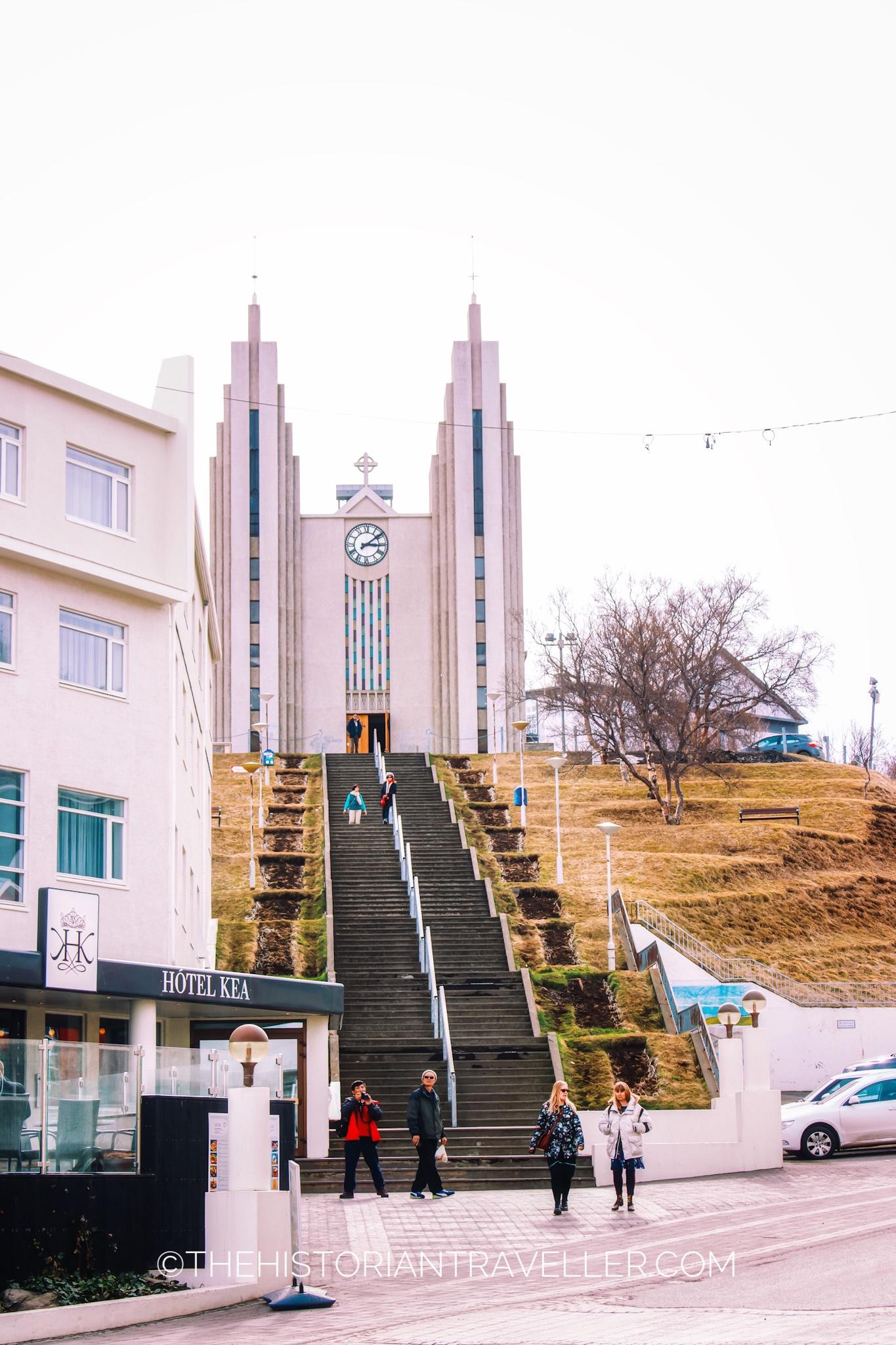
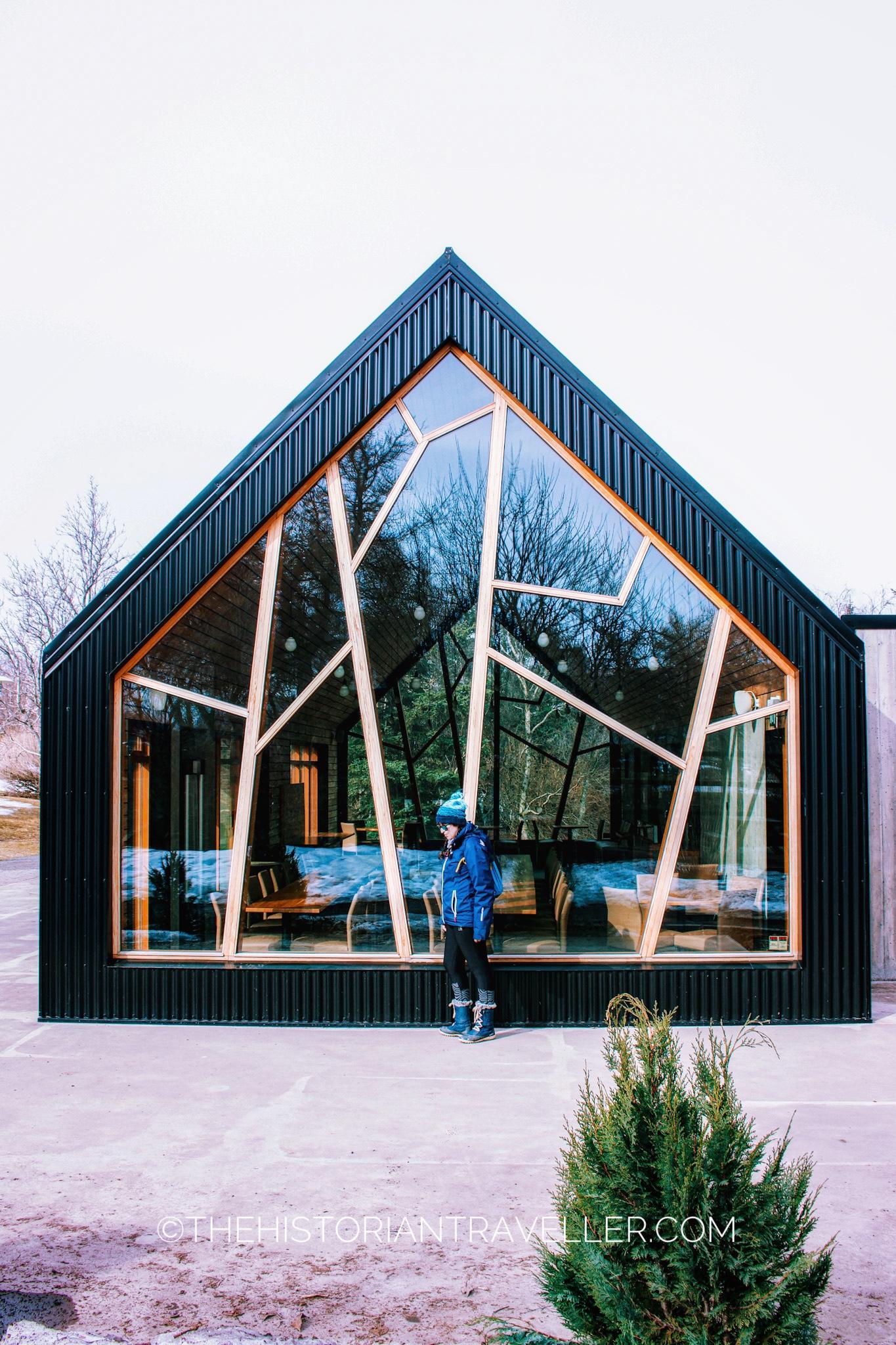
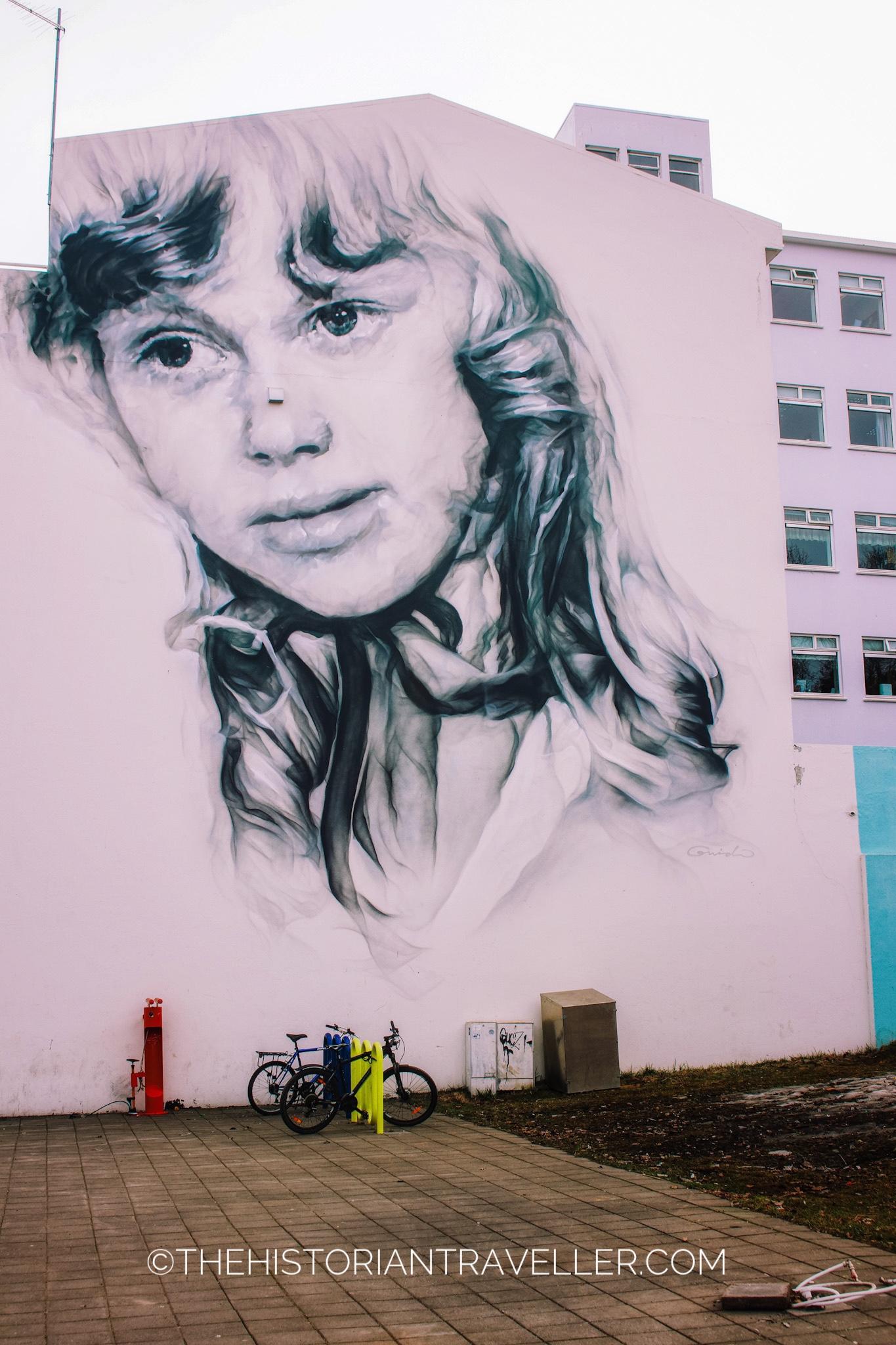
Akureyri is the second-largest urban area in Iceland, following Reykjavik. It’s often referred to as the “Iceland’s capital of the North.” According to Icelandic sources, the area was colonized during the early Middle Ages by Norse populations. Today, this vibrant city is primarily known as a fishing and cultural centre.
The city is much quieter than Reykjavik, especially in the winter and spring, with fewer tourists and crowds. Akureyri is a fascinating place, with its vibrant colours and lively atmosphere.
The city offers many charming cafes where you can warm up after a day of exploring in the cold North Icelandic breeze. One of the nicest cafes we visited was Bláa Kannan Café, located on the main street of the city, offering a great selection of cakes and freshly baked bread.
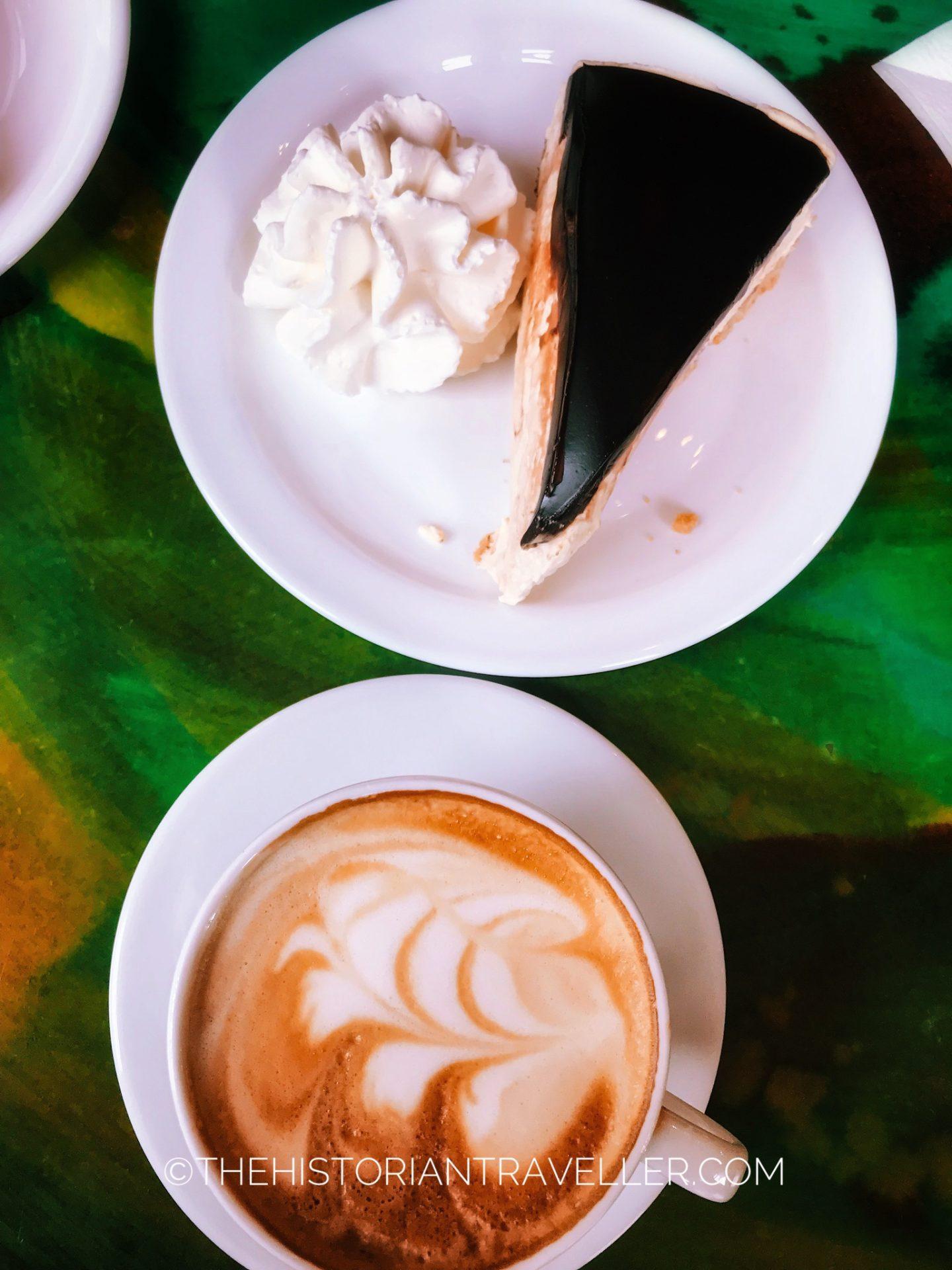
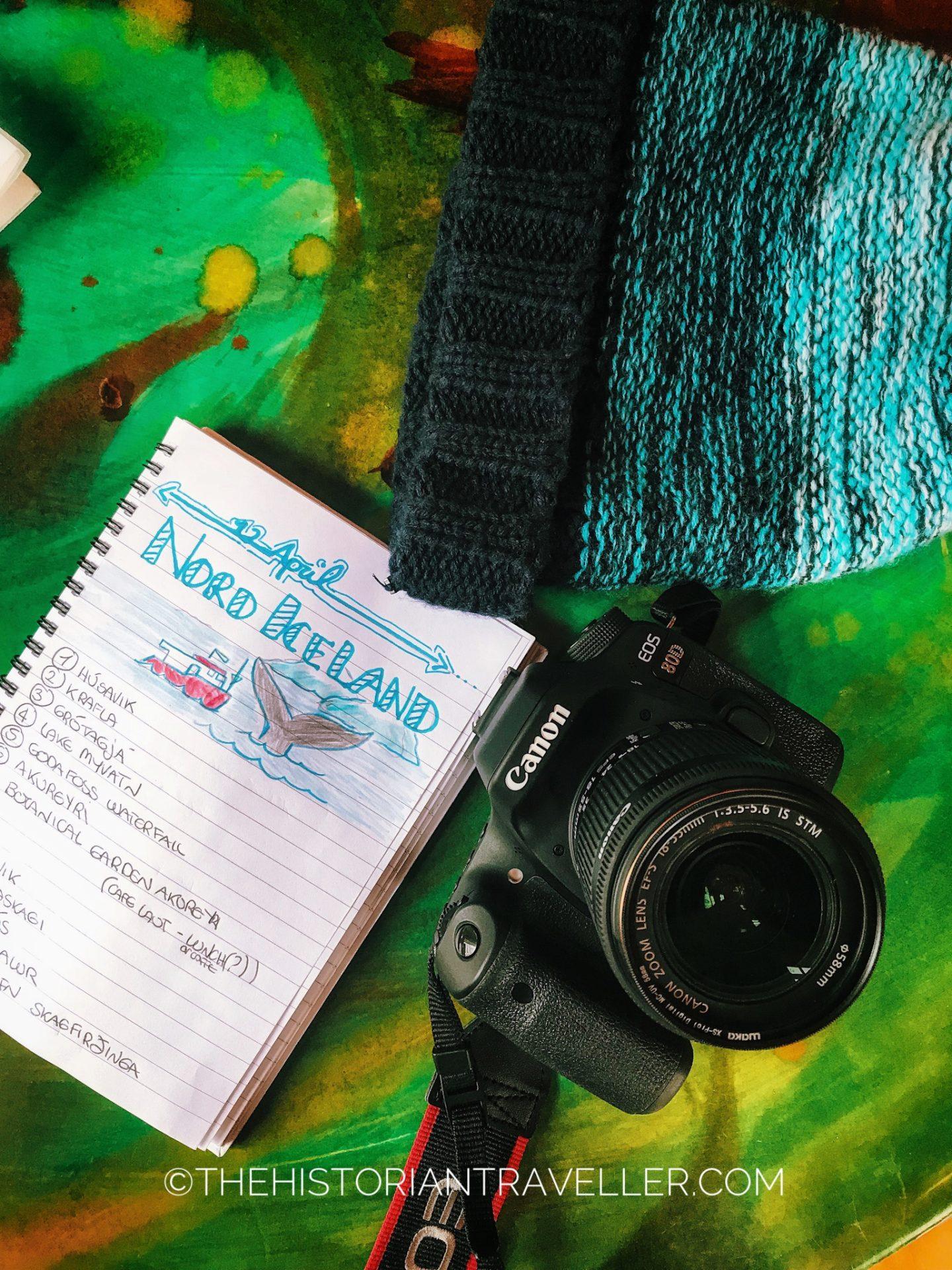
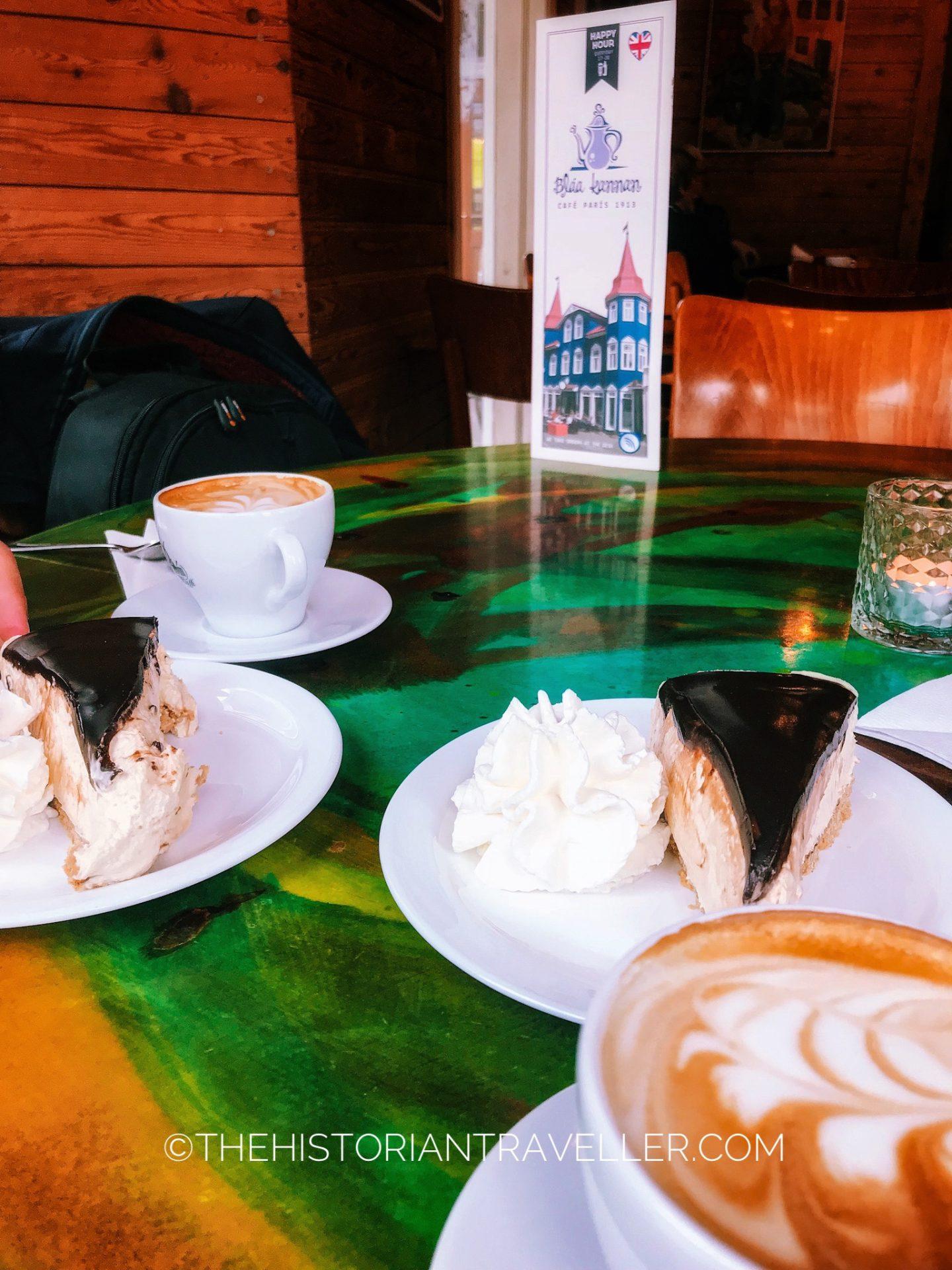
We truly enjoyed our time in this cozy cafe, especially when the weather outside was too cold for extended outdoor exploration. One piece of advice: when ordering food, especially cakes, it’s a good idea to ask about the ingredients. Icelanders have unique tastes, and you may encounter some unusual food combinations!
7) Visit the Icelandic version of the Shire at Glaumbær
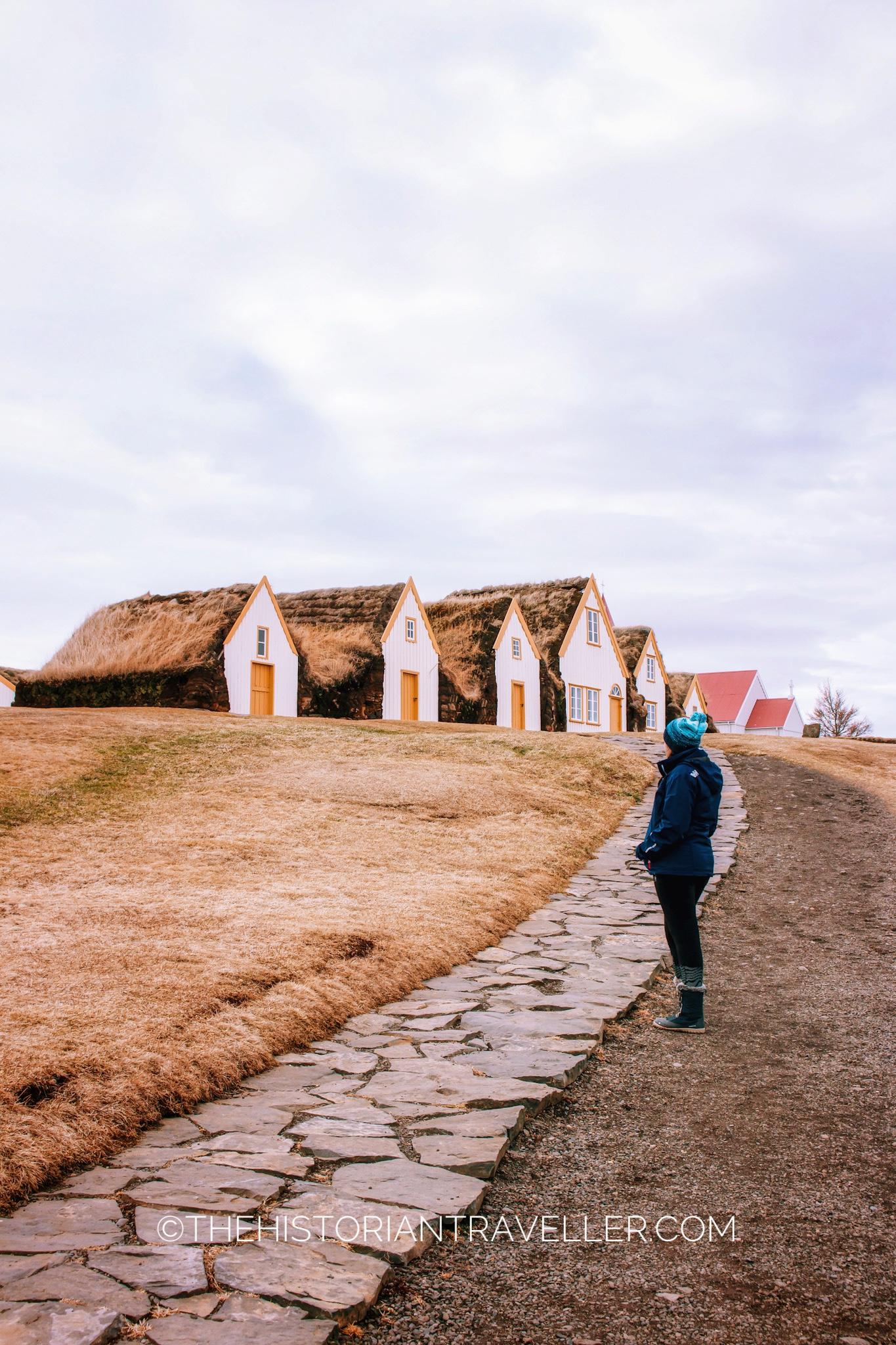
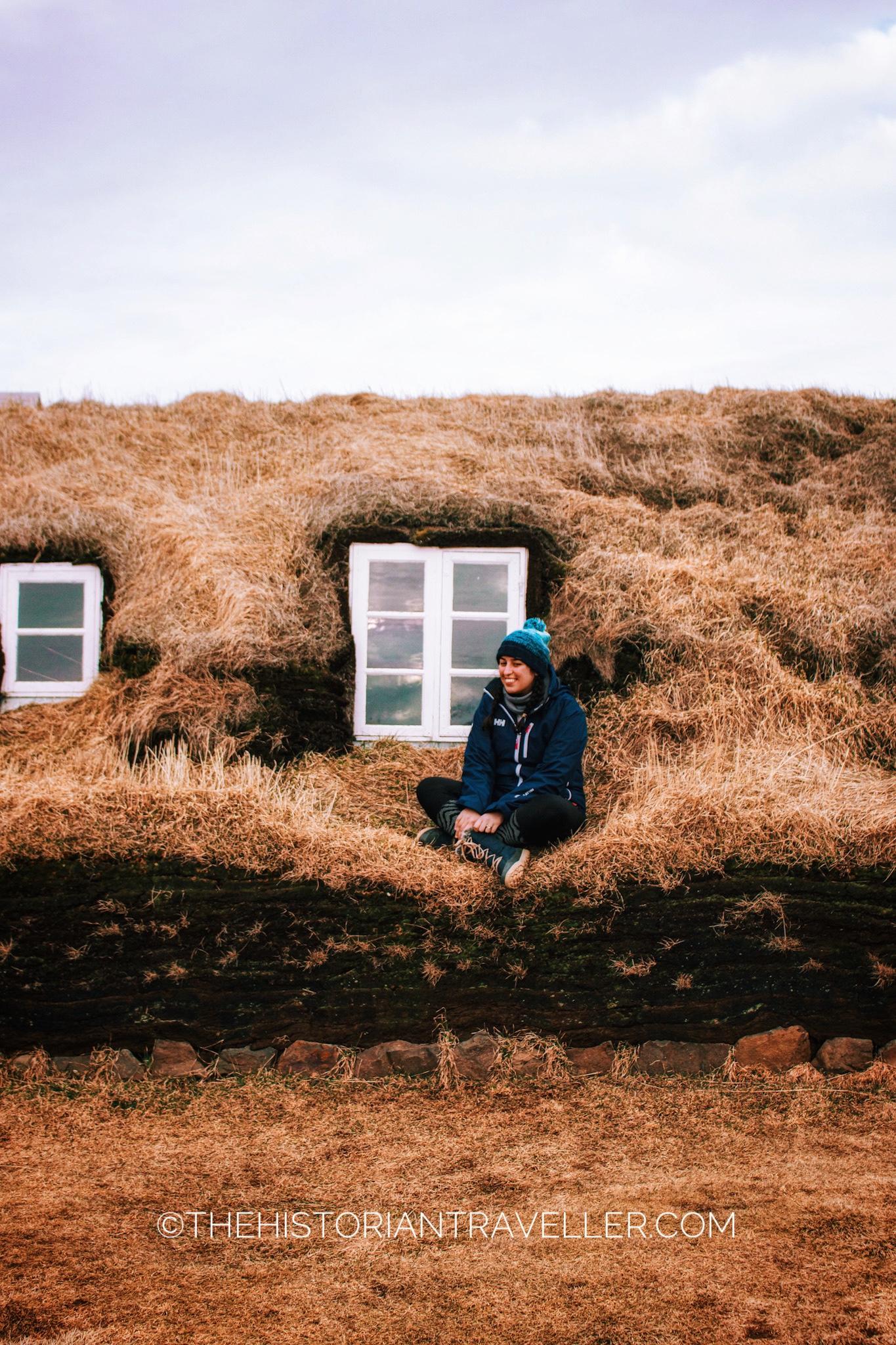
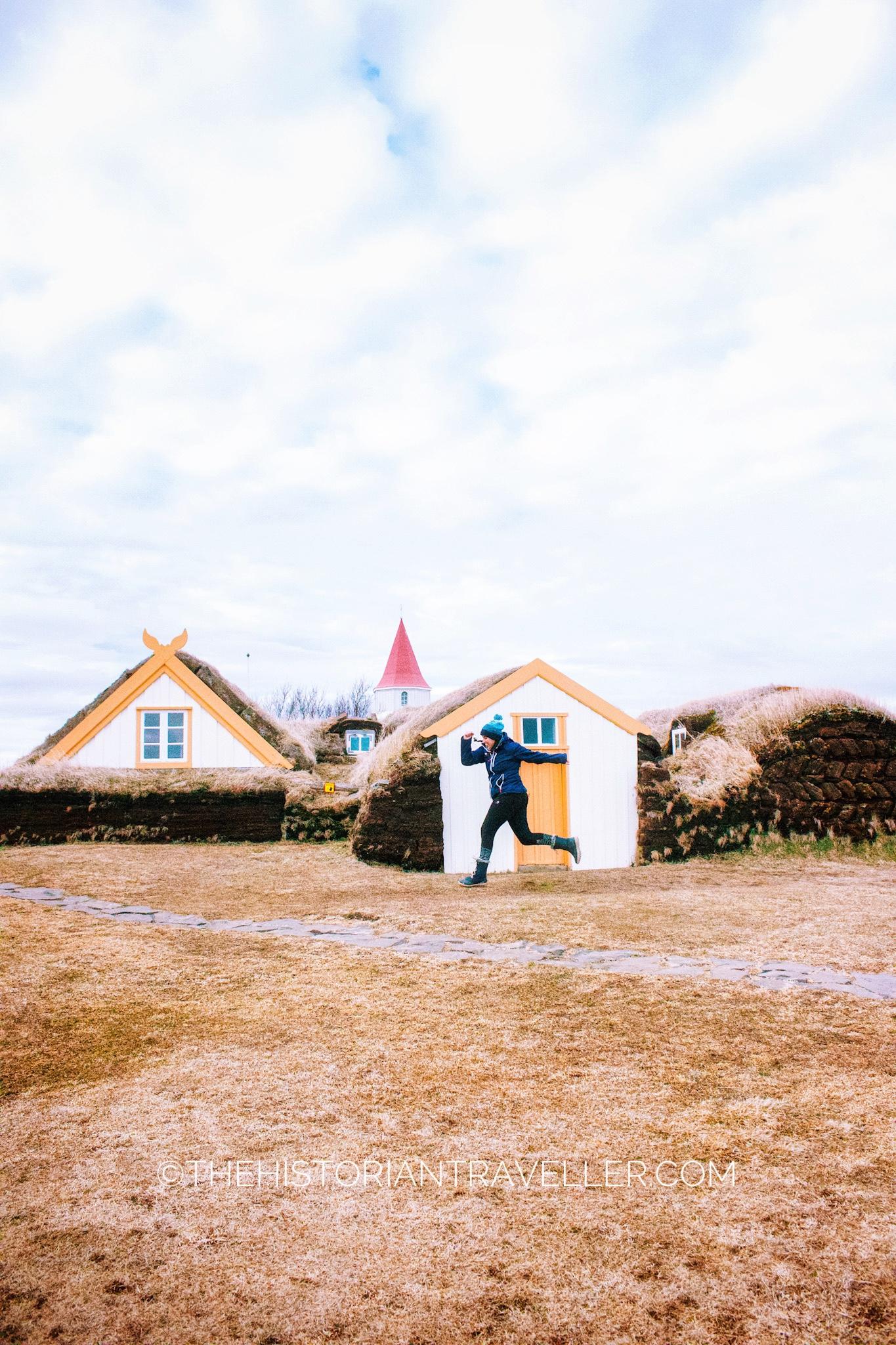
One of the highlights of our North Iceland itinerary was undoubtedly the isolated village of Glaumbær. The village is entirely constructed using the traditional turf-building technique. This has been used in Iceland since the time of the Vikings. While these houses were once inhabited by Icelanders, the entire area has now been turned into a museum.
Glaumbær dates back to the 18th century and is one of the best-preserved villages of its kind. In cold environments like Iceland, turf houses offered superior insulation compared to wooden structures, until modern architectural techniques were introduced.
It’s worth noting that until the early 20th century, many Icelanders lived in turf houses. However, with the advent of new technologies and improved insulation methods, turf houses gradually have been abandoned in favour of modern homes. Still, as you travel around Iceland, you can spot some of these characteristic buildings that are typical of the Icelandic landscape.
As a Tolkien enthusiast, I must admit I loved how this village resembled an Icelandic version of the Shire. The charming houses covered in grass and the vibrant colours set against the vast valley backdrop, felt like a scene from a Tolkien book.
Tips for visiting Glaumbær
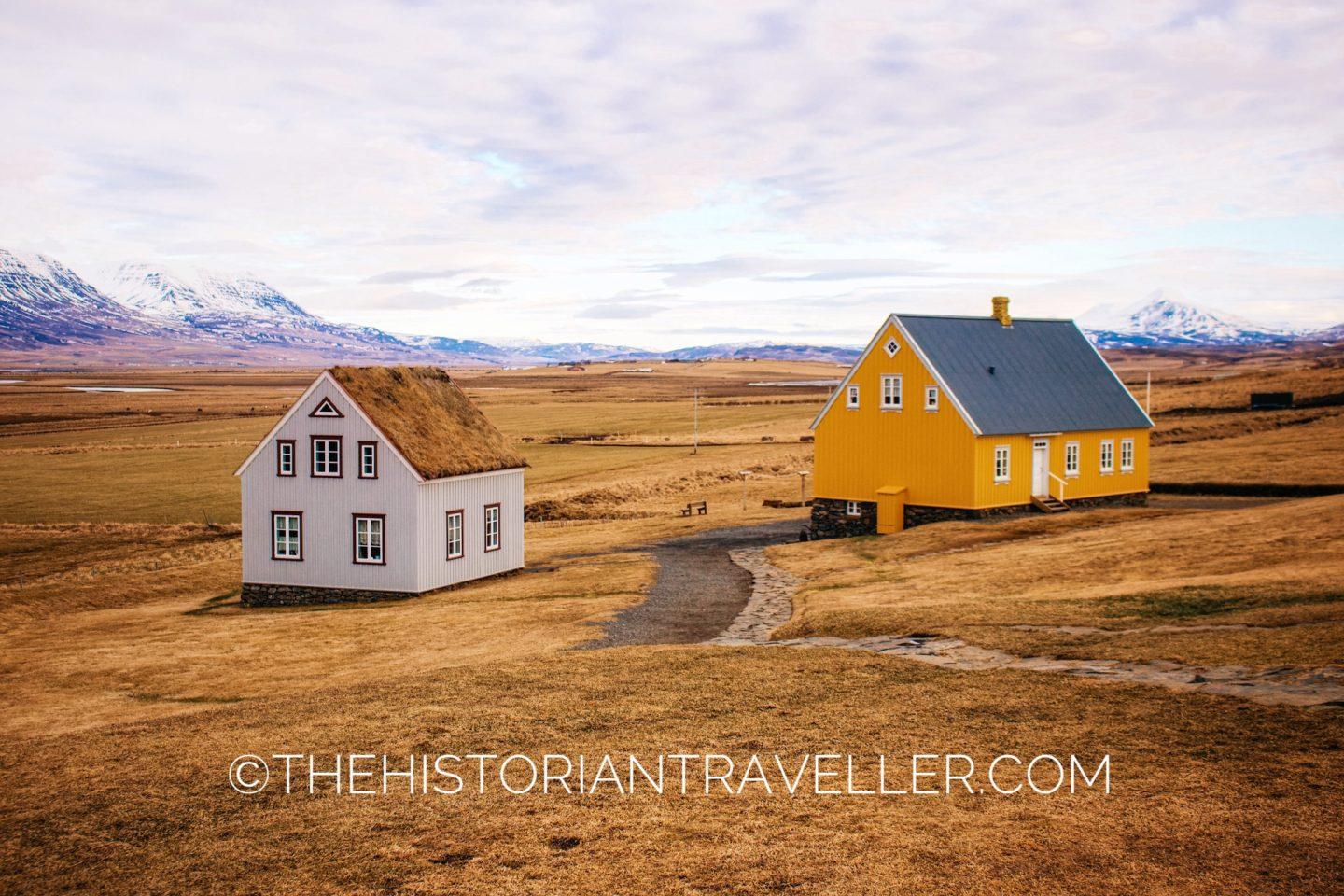
Glaumbær operates as a museum, and there is an entrance fee if you visit in the morning. However, if you choose to visit in the late afternoon or at dusk (as we did), you can freely stroll around these charming houses without any issues. During our visit, we were the only ones there at that time.
Keep in mind that you won’t be able to enter inside the houses during the late afternoon visit. That privilege is reserved for morning visitors. However, if your main goal is to capture some beautiful photos and soak in the unique atmosphere, the late afternoon is likely the best time to do so.
Where to Stay in Northern Iceland
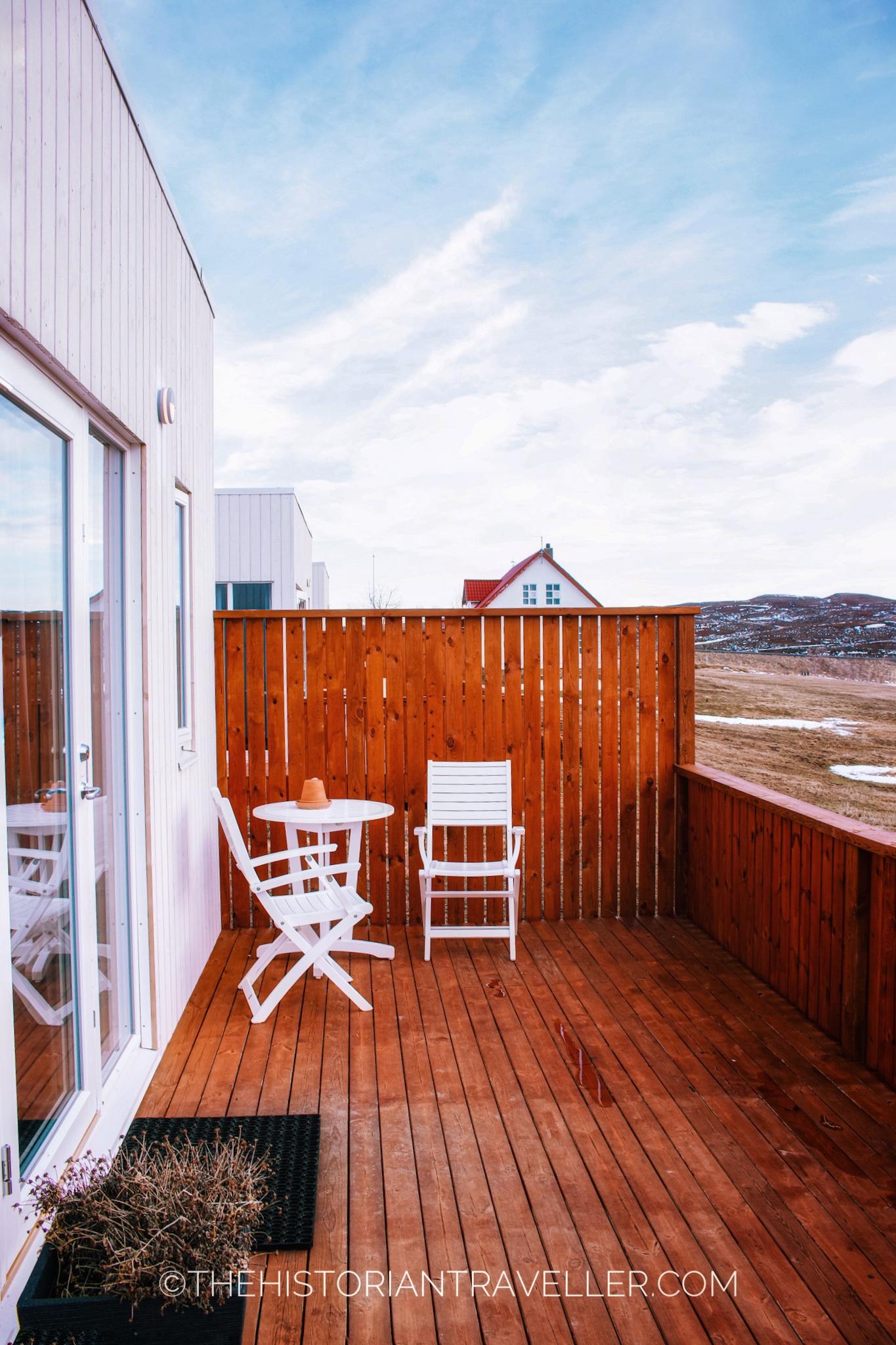

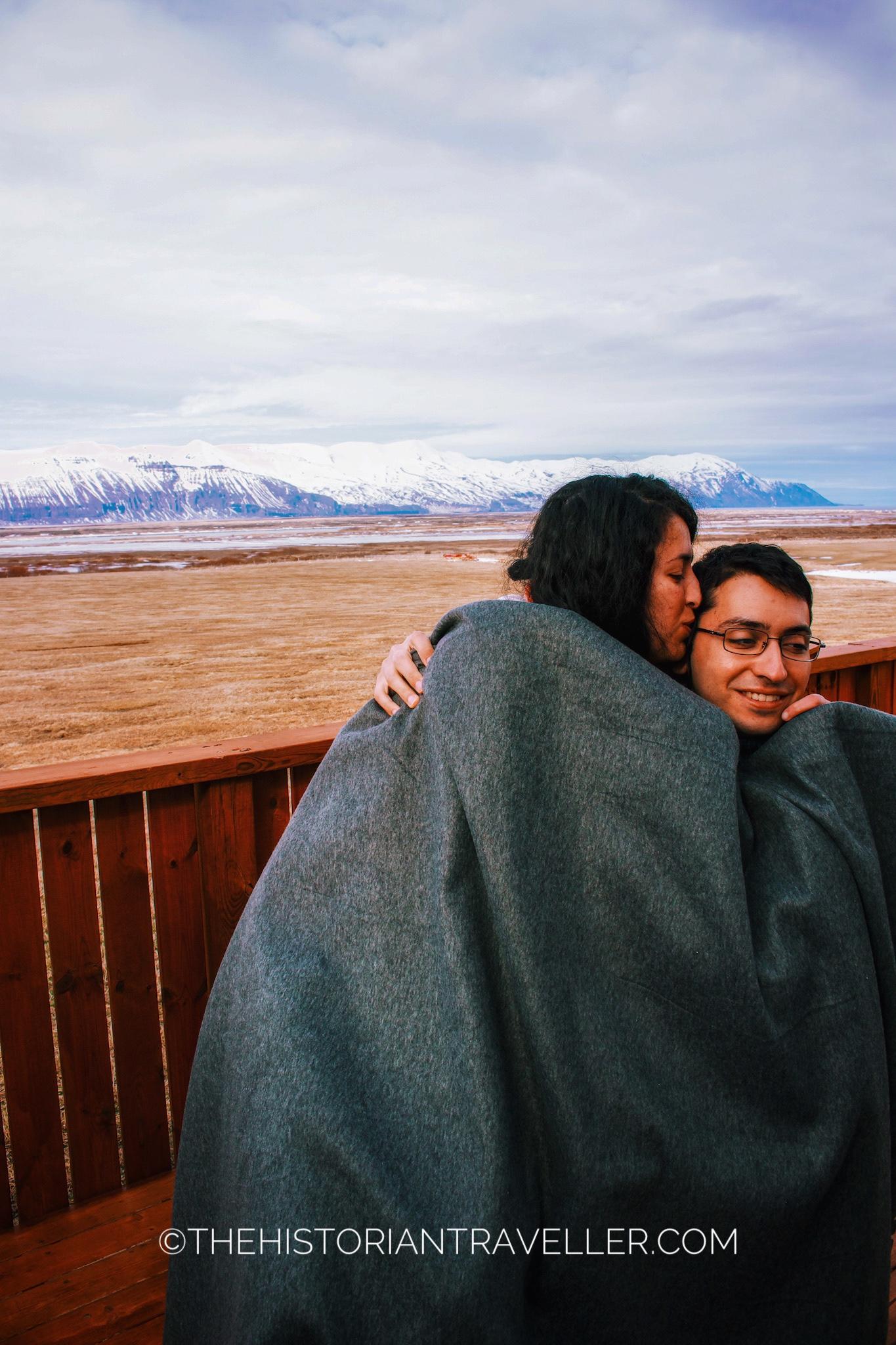
During our stay in Northern Iceland, we opted for two primary accommodations. On the first night, we booked one of the cube flats called Laxhús. This location is situated roughly 58.8 miles from Laxamyri and only 5 miles from Husavik.
Laxhús can be a bit on the pricey side compared to some other accommodations in Iceland, with a cost of about £170 or €200 per night. However, it offers excellent value for the price, providing all the amenities you need for a comfortable stay. The well-equipped kitchen includes a cutlery set, microwave, plates, and a coffee machine. You also get your own private terrace, a TV, and a spacious bedroom. Not to mention, the stunning Icelandic views directly from your window are worth the expense. Additionally, we were fortunate enough to witness the Northern Lights during our stay here. If you can’t catch the aurora from your terrace, you’re free to use the open area behind the cube for stargazing.
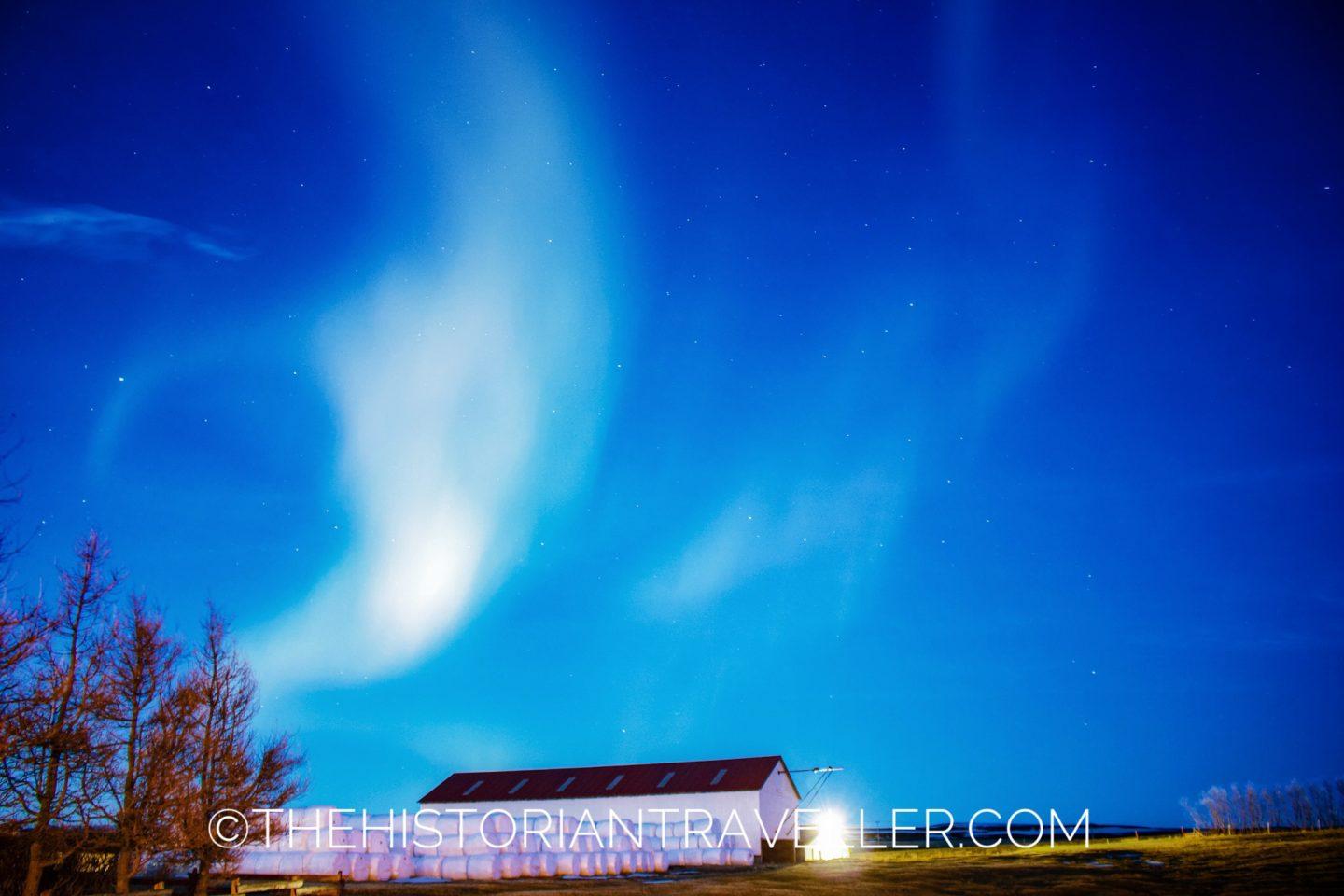
On our second night in Northern Iceland, we chose to stay at Guest House 46 (formerly known as Guesthouse Höfðabraut) in Hvammstangi. The hosts, Steinbjörn and Eva-Lena, were incredibly welcoming, making us feel right at home. Our room was on the smaller side but still cozy, and we enjoyed a fantastic view. Steinbjörn even prepared breakfast for all the guests in the morning. If you’re looking to connect with locals and experience an authentic Icelandic atmosphere, this is one of the best places to consider. Rates start at £65 per night for a double room.
Where to eat in North Iceland
Cooking at “home” during our North Iceland trip turned out to be a great choice. We found supermarkets in the cities of Akureyri, Húsavík, and Hvammstangi, which made it convenient to shop for groceries. Most Icelandic guesthouses are well-equipped for cooking, so we prepared our own dinners. Not only did we save more than 75% on our budget, but we also enjoyed the experience. Since many places outside of the major cities don’t have restaurants open at night, having a meal in the comfort of your accommodations is a practical and enjoyable option.
Plan your trip to Iceland
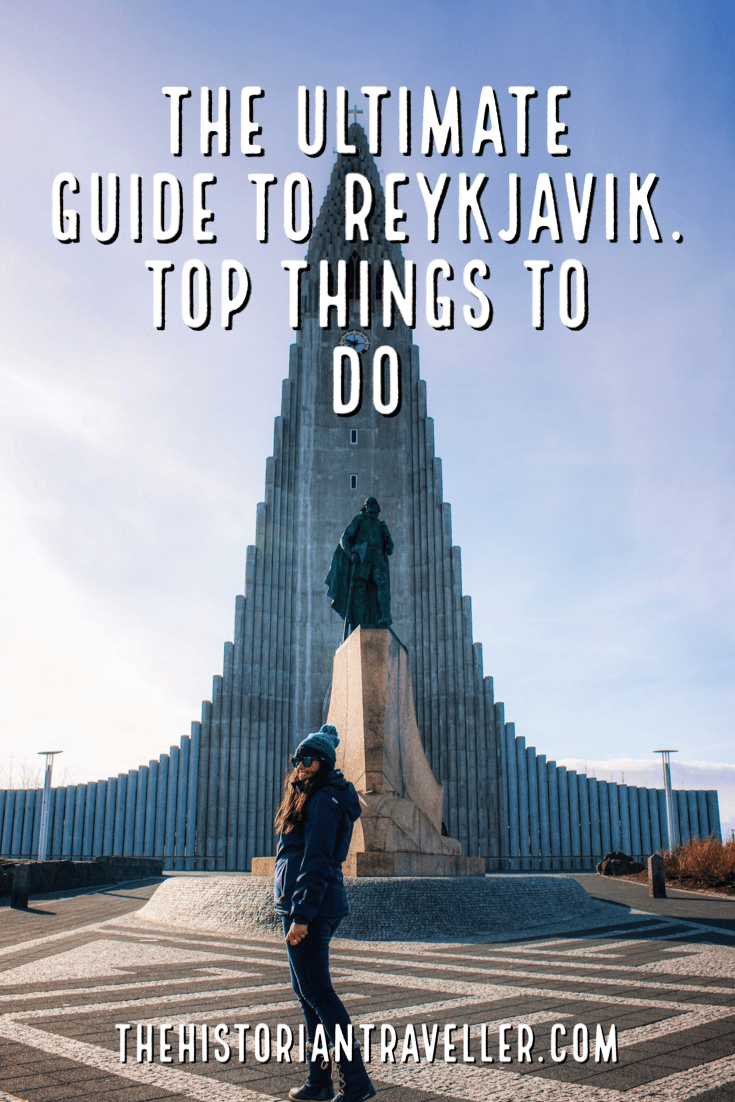
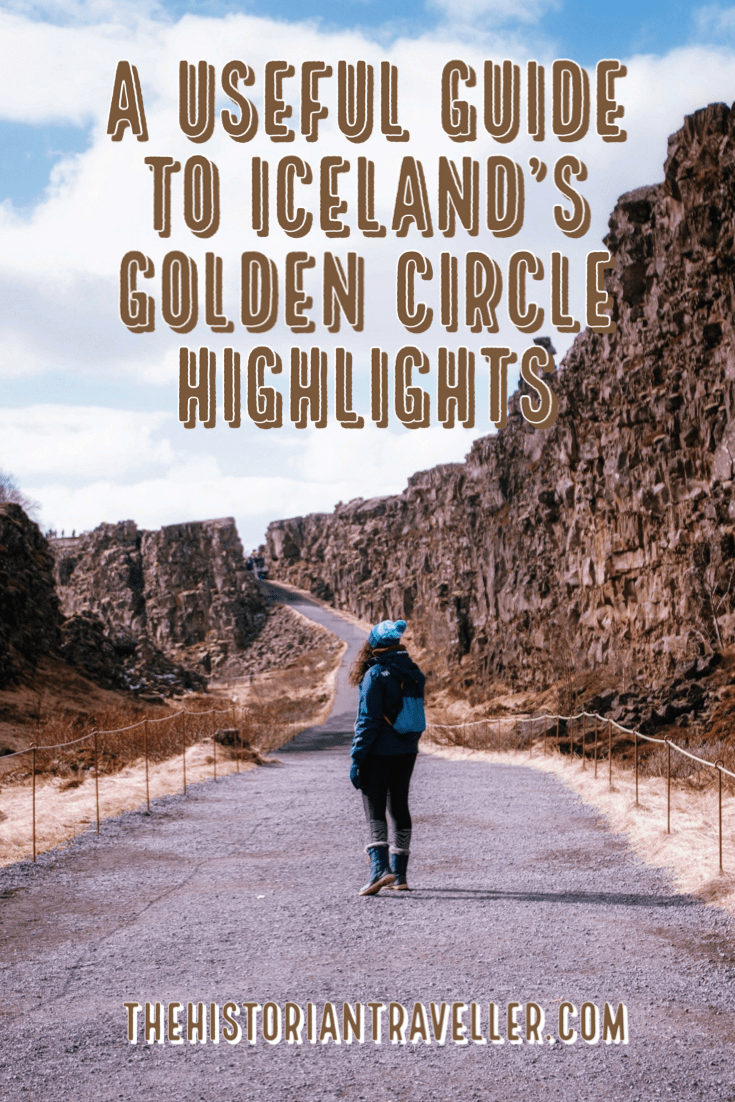
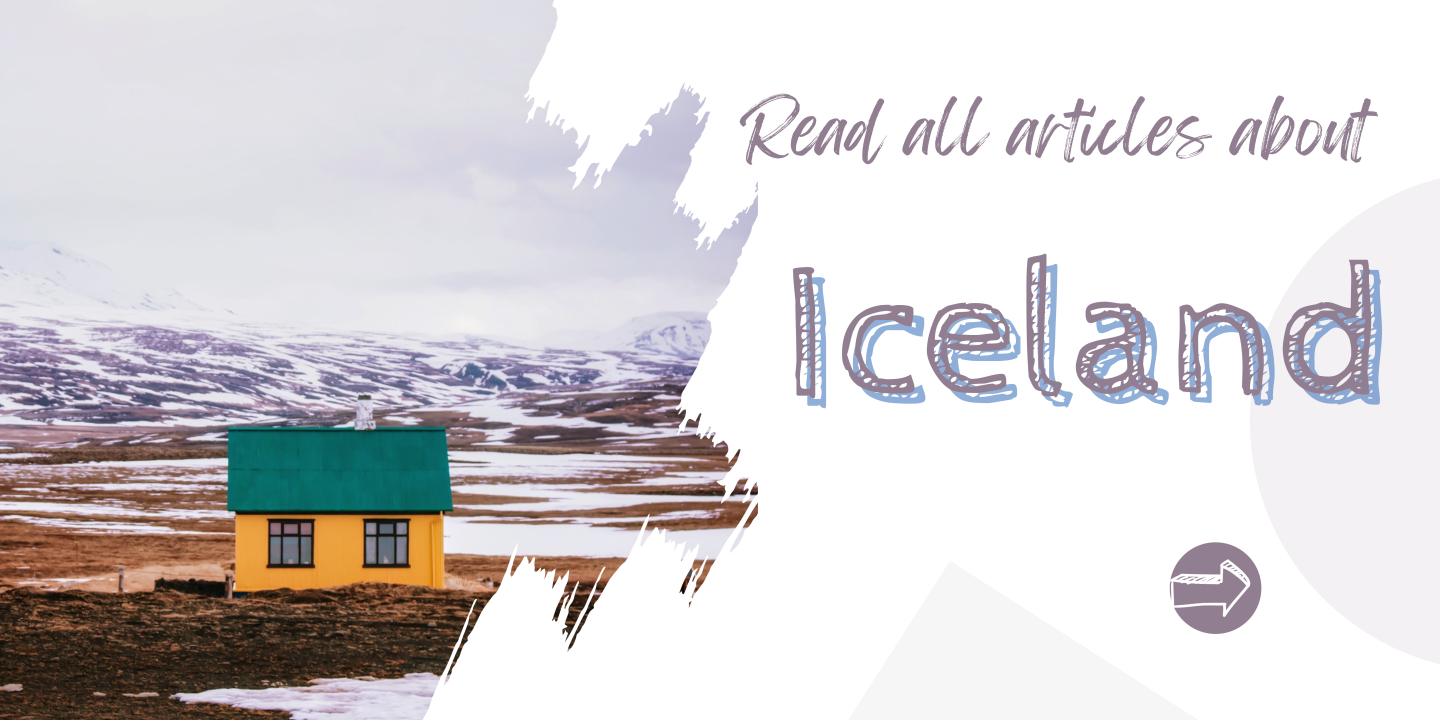
Liked this blog? Pin it for later!